No.118-156
Check It Out
No.156 (1/22/10)Love Love Show: The new conception of contemporary art exhibition projected by the Aomori Museum of Art & Towada Art Center
By Chiho Tsukiashi
Staff Writer
Open a curtain and step into a dark hall, and you might first be taken aback at the sight. Life-size dolls, dimly lit up, gaze at the air vacantly. Their clothes worn out, they seem to be European antiques treasured by girls for a long time. In the same space, palm-size boxes are lined along the wall. Look into them from viewers as you illuminate the holes with a flash light. They are the tiniest dollhouses. The dolls and dollhouses, two diverse art forms, are created by different artists, yet they effectively enhance each other to generate a wonderland.
Two contemporary museums, the Aomori Museum of Art and the Towada Art Center, share a common concept, “encounter,” for their special exhibitions this winter. Artists specialized in different genres such as painting, photograph, music, manga, and architecture meet to generate unique chemistry. As another exposition, manga and video are put together. On a large screen, you see revolving images of two-dimensional comic pages and three-dimensional georama. Although the two seem to be completely unrelated, the combination gives you the illusion of watching a drama.
A free shuttle bus between the two museums is available. It takes about two hours one way. We recommend that you start the tour from the Towada Art Center right after it opens at 9AM. Look at both the permanent and special exhibits, and take the 10:30 bus to the Aomori Museum of Art. Bring a brown bag lunch and eat it on the bus, or eat at a restaurant at the destination after the bus arrives at 12:30. (The meals at the restaurants are slightly more expensive.) Enjoy both the permanent and special exhibits. Ride on the 14:00 bus to take you back to Towada, arriving at 16:00.
LOVE LOVE SHOW
Date: Now through Feb. 14 (Sun)
Venue: Aomori Museum of Art (AMA) and Towada Art Center (TAC)
Hours: AMA 9:30 - 17:00
TAC 9:00 - 17:00
Closed: AMA: Jan 12 (Tue), Jan 25 (Mon), and Feb 8 (Mon)
TAC: Jan 18 (Mon), Jan 25 (Mon), and Feb 1 (Mon)
Admission (adults):
AMA: special exhibition only 900 yen
AMA: special and permanent exhibitions 1,300 yen
TAC: special exhibition 300 yen
TAC: special and permanent exhibitions 500 yen
No.155 (1/8/10)
"9" Misawa Community Market
By Nao H. Kauffman
Chief Editor

A Happy New Year!
To start a new year, visiting something new could be fun to do. At Miss Veedol Plaza, a farmer's market called “Ku no ichi market -- 9 market” (the day of 9th, 19th, 29th in every month) is held. You can find fresh fruits, vegetables, fish, flowers, shoes, boots and so on. All the items are very cheap and great. One stall closest to the entrance sells produce fully grown in Misawa. Some people sell warm foods like soup, ramen, grilled miso rice balls on sticks, and ethnic food etc. It starts from 9 a.m. till 5 p.m. across from the bigger Super ASAHI shopping center. Parking could be very limited.
You can also rent a half lot for 2600 yen either in the morning or afternoon or 5200 yen for a full day. Then, a whole lot costs double of the half lot. It will be a great opportunity when spring cleaning come to get rid of your household goods. You can contact Misawa Shopping Center at 0176-53-3280.
 When I checked out the market, I came across a new shop called “Pizza Armadillo” with an eye-catching green car. The owner, Mr. Hiroshi Tsuchiya was born and raised in Hachinohe and started selling his homemade light crusty pizza in mainly Hachinohe.
Last year, he decided to travel to Misawa from Hachinohe only for this event. In the back of his car, a small oven is attached to bake fresh pizza for 5 minutes. He confidently answered me that he makes his pizza dough from a scratch. Mix pizza (similar to supreme pizza) or shrimp mayo pizza are available only for 500 yen. It is a bit smaller compared to the traditional American pizza; however, it is decent size for quick snack. Once you taste it, you will definitely become a repeater.
When I checked out the market, I came across a new shop called “Pizza Armadillo” with an eye-catching green car. The owner, Mr. Hiroshi Tsuchiya was born and raised in Hachinohe and started selling his homemade light crusty pizza in mainly Hachinohe.
Last year, he decided to travel to Misawa from Hachinohe only for this event. In the back of his car, a small oven is attached to bake fresh pizza for 5 minutes. He confidently answered me that he makes his pizza dough from a scratch. Mix pizza (similar to supreme pizza) or shrimp mayo pizza are available only for 500 yen. It is a bit smaller compared to the traditional American pizza; however, it is decent size for quick snack. Once you taste it, you will definitely become a repeater.
No.154 (12/25/09)
Obara Bar: A Relaxation Spot in Misawa!
By Keiko H Johnson
Staff Writer
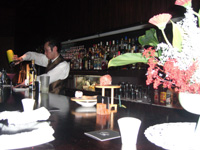 Nightlife in Misawa can get quite exciting on the weekends. After being busy with work or chores all week, going out to nightclubs and bars with friends and coworkers may help relieve fatigue and re-boost energy to face the upcoming busy week. There are a few places many may already have selected as their favorite bars or clubs to hang out on the weekends in Misawa. If you need a place to sit, relax, and enjoy tasty drinks, the bar called “ Obara Bar”, located on the second floor of the building across the street from the parking place behind Nakai Liquor shop by the American park, maybe the perfect place to go. Chilling in the stylish bar for a late- night drink will give you a perfect occasion to rest your mind.
Nightlife in Misawa can get quite exciting on the weekends. After being busy with work or chores all week, going out to nightclubs and bars with friends and coworkers may help relieve fatigue and re-boost energy to face the upcoming busy week. There are a few places many may already have selected as their favorite bars or clubs to hang out on the weekends in Misawa. If you need a place to sit, relax, and enjoy tasty drinks, the bar called “ Obara Bar”, located on the second floor of the building across the street from the parking place behind Nakai Liquor shop by the American park, maybe the perfect place to go. Chilling in the stylish bar for a late- night drink will give you a perfect occasion to rest your mind.
As you enter the bar, you will see fabulous modern interior that is plush and dimly lit; the single person leather chairs placed in front of the polished oak bar counter add splendor to its atmosphere. Behind the counter, the head bartender and the owner Mr. Obara, and the staffs professionally fix up cocktails and other beverages. Mr. Obara is a trained Bartender who won a first level prize at International bartender competition in Tokyo in 2009.
 Sitting in comfortable furniture after warm greetings from staffs at the bar, you will be given warm soup as starters. The Chocolate Fondue adds heavenly pleasure to the exhausted state of mind and body of those who constantly rush through the busy days. Such exquisite care given by the staffs allow visitors to enjoy their favorite beverages and offer an opportunity to indulge relaxing. According to Mr. Obara, offering the venue of relaxation and serving good beverages to the visitors, is the main concept of managing the business, he says.
Sitting in comfortable furniture after warm greetings from staffs at the bar, you will be given warm soup as starters. The Chocolate Fondue adds heavenly pleasure to the exhausted state of mind and body of those who constantly rush through the busy days. Such exquisite care given by the staffs allow visitors to enjoy their favorite beverages and offer an opportunity to indulge relaxing. According to Mr. Obara, offering the venue of relaxation and serving good beverages to the visitors, is the main concept of managing the business, he says.
The Obara bar stocks more than 1000 brands of malt whiskeys, liqueurs, along with nice selections of New World wines from all over the world. They serve a full range of cocktails and beers as well. For those who do not drink alcoholic beverages, fresh squeezed seasonal fruit juice in cocktail glass are available. In addition to the drinks, there's small food menu (smoked Ham, cheeses, and dried fruits) are served at the bar. The Jamon Iberico: the finest smoked ham from Spain, served at this bar is particularly delicious. The bar staff carves the ham as order is placed. The fees of the cocktails from 600 yen and 800 yen, which is considered not so expensive for a stylish cocktail bar in Japan.
Next time when you need a place to relax, talk, and enjoy drinks, I recommend you to visit Obara Bar. You may visit the bar with a group of your friends, or without friends, you will definitely find it comfortable to stay. If you don't see your favorite kind of cocktails on the menu, or if you don't know much about cocktails, Mr. Obara will fix a glass just for you that will satisfy your cravings.
No.153 (12/11/09)
Japanese Rice Balls -- Onigiri
By Keiko H Johnson
Staff Writer
Many Japanese say that food reflects on the culture of its origin. Rice is a staple food of Japan, and it appears at homes on the table as a main dish, at least once a day. Such high demands for rice in Japan fueled the nation to seek the highest quality in its flavor. Rice has been, in many ways, supporting the lives of people in Japan and plays a great role in establishing their food culture of Japan.
One of the best ways to enjoy the quality of rice in its flavor is to prepare rice balls by adding a pinch of salt into the rice before shaping it into balls. Rice balls are called Onigiri, or Omusubi, and they are usually served in a round or triangular shape. They are prepared in most homes in Japan and are the most popular entree for the children’s lunch box, especially during school events. Rice balls are commonly prepared with sour plums, flavored bonito flakes, or grilled salmon.
As the rice balls appear in one of the classic literatures of Murasaki Shikibu written in 1007A.D., the history of it is long. The traditional rice balls are made simply with lightly flavored rice, shaped into balls by hand, and wrapped by bamboo leaves. The rice balls prepared today are often made with various fillings within. Above all, Yakiniku-BBQ meat, Shrimp Tempura, Tuna with Mayonnaise, and such are innovative versions of the complete mixture of a full course meal.
Today, many grocery stores and convenience stores in Japan have launched the mass production of rice balls, and such modern technology has made obtaining rice balls easy for people without having to rush through the kitchen at the busiest time of the day. Rice balls sold in stores are wrapped in individual packages, and have a wider variety of flavors, that consumers will definitely be able to find their desirable flavor at each visit.
Although it may be difficult to reach out and grab things which might not be familiar to you, Japanese rice balls are worth trying. I am listing a few of the fillings below, hoping that it will help many to experience and to discover your favorite flavor of Japanese rice balls.
Grilled Salmon: 鮭
Pickled Sour Plum: 梅
Flavored Bonito flakes: おかか
Yakiniku: 焼肉
Flavored rice with chicken: 鶏五目
Cooked Sea Kelp: 昆布
Spicy Cod roe (cod eggs): 辛しめんたいこ
Salmon roe (salmon eggs): すじこ
Pickled Vegetable: 高菜
Spicy Miso: 辛し味噌
Tuna with Mayonnaise: ツナマヨネーズ
Shrimp with Mayonnaise: エビマヨネーズ
Fermented soybeans (Natto): 納豆
Sweet rice with red beans: 赤飯
No.152 (11/27/09)
Great discounts and great selections at Takeda Sports Shimoda
By Keiko H Johnson
Staff Writer
Burton, Roxy, Solomon, Head, Flow, K2, and many more items from the popular production brands are available this winter at Takeda sports in Shimoda. Skis, snowboards, boots, winter outerwear, and even thermal underwear with a wide range in sizes began to fill the shelves with red tags. The beginning of the season's sale begins next week. The second greatest news from Takeda Sports for this winter is their 10% store coupon offer on every $100 purchase. If you buy a set of skis, including the poles and the bindings for $199, you will receive $10 store credit, but if you spend an additional $5 on a pair of socks and exceed $200 on your total purchase, you will receive a $20 store credit (10% cash discount by military ID is not applicable at the same time). As well as the merchandises sold at the second floor, varieties of items at first floor are sold at discounted prices. Great selections and the good prices on winter sports items are now on sale at Takeda Sports in Shimoda.
The selection of winter items at Takeda Sports will also give you many great ideas on holiday gifts. Among some, the newest snowboard model available, the Rocker, the product of the latest technology from Lib Tech Co., is predicted to attract a great deal of attention this year. The Rocker is the newest type of snowboard, which offers enhanced flexibility for effortless control on the board. The slightly dented center and the rough edges on the board make snowboarding the more amusing and exciting sport. These types of snowboards are suitable for beginners to intermediate level snowboarders; yet, it is best suitable for those who truly enjoy the performance style of snowboarding style to get the pleasure from the traditional down hill style. The Rocker high-tech snowboards have been adapted by many other popular brands. If you are interested in checking out the newest models, you should drop by Takeda Sports Garden Plaza Shimoda.
Other than snowboarding items, Takeda Sports also gives great deals on winter outfits, ski sets, and thermal wears. While the colors of new models of winter outfits fill the floor with vivid colors such as yellow, orange, red, white, black, and many more, which will definitely fill the ski slopes this year, the selected outfits from the previous year’s models can be purchased for less than $100. Sizes are limited on those items; thus, they will be sold on a first come first serve basis.
Additionally, all these items listed above are available in kid's sizes as well. Kid's ski sets, snowboards, winter outfits, and others can be found at the store for reasonable price.
Additional information on group purchasing at Takeda Sports: For groups of friends and families, parents, and teachers, even those children attending school sports, just ask to get 20% off discount on the purchase of a bulk of more than 5 of the same items. So, if there are more than 5 people in need of the same items, gather up and order today!
No.151 (11/13/09)
7.5.3 (七五三)
By Nao H. Kauffman
Chief Editor
七五三 (shichi go san): seven, five, and three 千歳飴 (chitose ame): chitose candy
Shichi-Go-San is an event to celebrate the passage into middle childhood for children growing out of babyhood. It is usually on November 15, a day of full moon, when parents take three or five year old boys and three or seven years old girls to shrines to pray for their health and a successful life. On the lunar calendar, the day of the 15th used to be a lucky day since Japanese goblins (Oni) were not around; moreover, people used to give thanks for the harvest in autumn to the god of shrines and ask a blessing for their children's growth and their longevity as well.
Children normally dress up in a kimono or a hakama and visit shrines near their homes. Some just step up to the money donation box called Saisenbako for a hurried visit while others actually reserve seats and receive a special blessing from the shrine priest by donating on average 3,000 to 5,000 yen per child. Also, girls put make-up on for the first time. This ritual nowadays is also adapted to the western style as many of the parents also have their children dress up in western style attire for the professional photographs. Those three odd numbers were also believed as lucky numbers from the influence of the Chinese Ideology.
Children receive special candies called chitose ame upon their visit. Chitose literally means 1,000 years old. This candy is in fancy bags with a combination of cranes and turtles pictures or a set of pine trees, bamboos, and plums on them. These symbolic candies are usually made from sugar with chewy candy called mizu ame, are 15mm diameter and up to one meter long, and are red and white in color. Over all, the candy stands for “something fortunate.”
Tamura Studio, right outside the main gate, offers a great deal for photo packages, including kimono rentals, for military families, regardless of age or event. Why not trying on a beautiful kimono and send a unique holiday greeting?
No.150 (10/23/09)
Japan Culture Exhibition
By Nao H. Kauffman
Chief Editor
When it comes to autumn, people commonly relate it to many activities in Japan. During this season, the Japanese people usually gravitate towards art, music, culture, sports, leisure, reading, great appetite, delicacies of the season, or crimson foliage. They tend to sublime themselves by enjoining many of them. A good example is November 3, a holiday called “Bunka no Hi -- Culture Day.” Many schools take place an event called “Undoukai” around this season -- students challenge dancing, running races, or playing competitive games like sports Olympics. Some schools perform chorus recitals or plays.

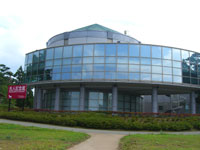 Driving the road to the north, outside the east side of Misawa Air Base, there is a road stop called Michi no Eki Misawa (Tonan Clan Tourist Village,) where Misawa-shi Memorial Hall for forerunners is located. You can view some historical items and learn about the history of local forerunners. Until November 3, Japan Culture Exhibition featuring the collector, Katsutoshi Yasuda presents his valuable vintage items. Admission fee for adults is only 100 yen. Children under 15 years old cost 50 yen except Saturdays (free).
Driving the road to the north, outside the east side of Misawa Air Base, there is a road stop called Michi no Eki Misawa (Tonan Clan Tourist Village,) where Misawa-shi Memorial Hall for forerunners is located. You can view some historical items and learn about the history of local forerunners. Until November 3, Japan Culture Exhibition featuring the collector, Katsutoshi Yasuda presents his valuable vintage items. Admission fee for adults is only 100 yen. Children under 15 years old cost 50 yen except Saturdays (free).
In 1969, Mr. Yasuda was born in Hachinohe. Since his college life, he has started collecting retro tin toys, vintage animation figures and so on, and now has reached almost 7,000 items. Recently, he had a special opportunity to lend his attached collections for the movie called “Twentieth Century Boys.”

 At the exhibition, you can view some modern items in Showa period (1926-1989) such as Super Mario, Gundam series, Dragon Ball etc. while other traditional old items are displayed beside them. Once you step in, many of Japanese would feel nostalgic and recall their old good memories. Those cherished items and works are still now come down to their children and to the world. I took my five and three year old children on the first weekend of October. When looking at their excited smiles right against the glass show case, I thought the times run slowly. There is a park and a small restaurant with local freshly cropped items sold. At the kiddie zoo, you can see two baby reindeer, which were born in June.
At the exhibition, you can view some modern items in Showa period (1926-1989) such as Super Mario, Gundam series, Dragon Ball etc. while other traditional old items are displayed beside them. Once you step in, many of Japanese would feel nostalgic and recall their old good memories. Those cherished items and works are still now come down to their children and to the world. I took my five and three year old children on the first weekend of October. When looking at their excited smiles right against the glass show case, I thought the times run slowly. There is a park and a small restaurant with local freshly cropped items sold. At the kiddie zoo, you can see two baby reindeer, which were born in June.
No.149 (10/9/09)
Laser Eye Surgery in Japan
By Nao H. Kauffman
Chief Editor
“No more glasses, no more contact lenses. Now I can see!” Every day when I wake up in the morning, I am glad that I got my LASIK surgery done in Tokyo last year. Before the surgery, I used to experience many discomforts from the eye irritation by wearing contact lenses and numerous inconveniences by wearing eyeglasses or even forgetting where I put my glasses. Without putting them on, I could not start a day.
Before moving to Misawa, I went to a clinic for a free consultation in California because I wanted to know the price. My curiosity and desire for the surgery got stronger after my eye doctor or a few friends told me their experiences at Travis AFB and their successful results. Unfortunately, TRICARE would not authorize the coverage of the surgery for dependents. At the moment, I was more nervous and scared until I heard other patients' happy voices in the waiting room. The procedures to determine if you are a good candidate for the surgery were as simple as a regular eye check-up. I could learn how the clinic performs the surgery and ask questions to the doctor at the clinic in California, the doctor suggested that I should try it right then if I could afford over $3,000. With confirming how amazing my post-operative life would be, I sincerely apologized that I was not ready for it because I was still nursing my daughter. He strongly recommended sooner is better after I quit nursing. Although I reluctantly went home because I could not jump into the surgery after knowing its simplicity and my possibility, my visit was very meaningful. Instead of paying for daily contact lenses every year or renewing my glasses, having the surgery could be more economical and a great investment.
After finding out our PCS to Misawa in 2007, I started web researches about the surgery in Japan and learned the surgery prices vary by different local providers. As laser eye surgery is like cosmetic surgeries, local providers determine the charges. Without popularity and price competition in this area, the surgery price is still greatly higher than bigger cities. On the other hand, many clinics in Tokyo lower the prices with more advanced technology because they reduce advertising costs by clearly showing the prices at their homepages and rely on word-of-mouth by spreading discount coupon referral tickets.
Surprisingly, the price for the surgery (premium IntraLASIK) that I received for 175,000 yen drastically dropped down to 118,000 yen within a year (currently no discount applied) at Shinagawa Lasik Center. My father received a rebate of 40,000 yen out of the price that I paid when I used the referral ticket. As a matter of fact, the cost for the surgery was 135,000 yen which included a free consultation (day 1), surgery fees and supplements (day 2), and postoperative check-up (day 3,) plus I had to pay additional expenses for air transportation and two nights accommodation costs. Having LASIK surgery done in Japan can be greatly cheaper than the US. I strongly recommend Shinagawa Lasik Center (品川近視クリニック)because they have been the top in Japan and granted many awards for their highest quality and great results; moreover, they provided the procedures over 600,000 people. It would be the world top record.
Now they offer more advanced technology for higher prices with the better natural results. However, they would be still cheaper than anywhere else.
Please check their Website for more details. To reserve your free consultation and for the actual operation, you will be required to be accompanied by a Japanese interpreter. Some of the doctors are bilingual. The clinic certainly would recommend the best procedure for you. However, you will be the one who makes a decision and picks the adequate choice within your budget. So, you should learn about the types of laser eye surgery beforehand.
I would not like to give you a wrong idea. To tell the truth, I am still nervous about my eyes when I think about what if. I have to be cautious about eye damages or infections. I am still having a hard time to get used to driving at night because of the side effect called glare or my eyes easily getting tired. To prevent from dry eye, I still regularly use eye drops for the care. Nevertheless, I have never regret about the surgery. It has been over a year after the surgery in the last June. My vision is still better than 20 even though it was worse than 20/160 before the surgery. I deeply feel happy and blessed that I can naturally see the clock when I wake up at the middle of the night. The price for my eyes was worth to appreciate every little moment.
No.148 (9/25/09)
Nasu Resort: 那須高原
By Nao H. Kauffman
Chief Editor
Summer in Misawa is very short, and the weather is extremely changeable. The southern area near Tokyo is still late summer, and soon beautiful autumn with mild climate follows afterward. Have you ever thought about driving farther than Morioka, somewhere that you can enjoy outdoor activities or enjoy exciting days in one area, instead of visiting a busy city like Tokyo? Nasu resort highland is the place to go! Nasu is located in Tochigi prefecture, a little farther south from Sendai on the Tohoku Express Way (Toll Road)/Route 4, near Nasu I.C. or Nasu Kougen Smart I.C. It is well known as a one-day getaway destination for golfers from Tokyo or its suburbs. However, there are so many things to do in the area. The Japanese Royal families visit there annually for their vacation. Many people also spend their holidays there camping, climbing, hiking, fishing, golfing, skiing, snowboarding, or visiting museums and so on. A variety of accommodation is available; for example, camping sites, guesthouses, bed and breakfast, resort hotels, or Japanese traditional ryokan with hot springs available. This area is pet friendly. Many shops admit dogs and accommodate your stay with your dogs. The Nasu’s downtown reminds me of a small town called Carmel near Monterey in California. If you do not like the cloudy weather here during the cold season, you should check it out.
The sightseeing spots are as follows. (Japanese only, but check the pictures!)
General Official Guide
Parks
Nasu Animal Kingdom
Nasu Highland Park
Nasu Safari Park
Nasu World Monkey Park
Museums
Nasu Stained Glass Museum
3D dinosaur museum
Nasu Classic Car Museum
Nasu Teddy Bear Museum
Nasu Orgel Museum
Farms
Nasu Heartland, the sweets world
Minamigaoka Dairy Farm
Admission free!
Lake Rindo Leisure Park
Mt. Jeans Ski Resort
Gondola ride and trekking spot during off-season
Accommodations/ Camping sites
Mori Box Play park
Shiobara Green Village
Dining
Stake House Kiku
The Cheese Garden
Sapporo Beer Brewery
Shopping
Nasu Garden Outlet
Nasu Resort Shopping Park 661 Street
No.147 (9/11/09)
Takeda Sports
by Robert Finley
Chief Writer
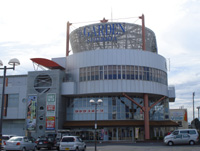 Right across the street from the Jusco Shimoda Mall sits a sports store that can fulfill all your sporting goods needs. Don't believe me? Take a trip to Takeda Sports, housed in The Garden Shimoda building and see for yourself!
Takeda Sports is a chain of sporting goods stores all over Tohoku that offers competitive rates on all kinds of sporting goods. Their staff of 25 associates is always available to help you find what you are looking for.
Right across the street from the Jusco Shimoda Mall sits a sports store that can fulfill all your sporting goods needs. Don't believe me? Take a trip to Takeda Sports, housed in The Garden Shimoda building and see for yourself!
Takeda Sports is a chain of sporting goods stores all over Tohoku that offers competitive rates on all kinds of sporting goods. Their staff of 25 associates is always available to help you find what you are looking for.
 When you first step into the massive Garden Shimoda building, you may be overwhelmed by the enormity of the place. As you enter the gigantic two-story building, the first thing you encounter is their large discount area, where you can find good deals on a wide variety of sports-related clothing and other items. To the left is the bulk of the store's sporting goods, where customers can browse through an impressive selection of shoes (up to Japanese size 29, U.S. size 10, constantly in store), sports clothing, and various sporting equipment, for everything from running to basketball to camping.
When you first step into the massive Garden Shimoda building, you may be overwhelmed by the enormity of the place. As you enter the gigantic two-story building, the first thing you encounter is their large discount area, where you can find good deals on a wide variety of sports-related clothing and other items. To the left is the bulk of the store's sporting goods, where customers can browse through an impressive selection of shoes (up to Japanese size 29, U.S. size 10, constantly in store), sports clothing, and various sporting equipment, for everything from running to basketball to camping.
But what if you can't find what you want? Surely the language barrier is too much to overcome when you're an American or other English-speaking citizen that doesn't know a word of Japanese, right? Wrong! Takeda Sports has an English-speaking associate by the name of Michele who is there to help you find what you need.
“Whatever we don't have, we can order,” Michele said of the items customers may not find available in-store.
All year round, you're likely to find a good deal on items in their inventory.
“There's a lot of discounts all the time,” Michele said. “We're always having sales.”
In addition to their sales, they also offer a 10% discount on regularly priced goods for anyone who has a base-issued ID card.
“(Some sports stores) offer a 5% discount, so I thought, ‘why not 10%?’” Michele said of the discount she suggested it to store management. “I try to understand what the customers are going through.”
On sale sometime in September are season passes for a number of ski resorts, such as the Appi, Shizukuishi, and Ajigasawa ski resorts.
The store also offers discounts for team uniforms. If you have a team of five or more and need uniforms, they can offer a 20% discount on the total cost.
Be sure to ask for Michele if you have any trouble finding things in the store. Their hours are usually 10 a.m. until 8 p.m., although their hours change slightly with the seasons.
No.146 (8/24/09)
Promise that you will never leave me...
"I do" is the moment of sweet Aloha...
by Nao H. Kauffman
Chief Editor
In the previous publication I introduced Hawaii as the greatest destination from Misawa for a vacation. However, the Hawaiian Islands also offer many sites for a wedding ceremony, a vow renewal, or special commitments, as well as your honeymoon. Being in the military, it is always hard to be with your family and friends back home, plan your vacation or any other kind of events. I wonder how many of you find the “one” you want to spend the rest of your life with, but cannot make a perfect plan for your “dream wedding” or had a hard time finding a perfect place for your special day because of unexpected assignments or personal matters. I believe some have started a family at an early age with pride and integrity, as a member of the U.S. military, while others still pursue and enjoy their single lives until they find the “one.” My husband and I got married at a Justice of the Peace in 2002, and had to postpone our wedding for seven years due to many unexpected circumstances.
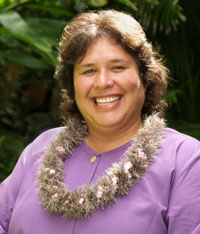 The Hawaiian Islands have many beautiful and amazing locations where you can hold your “special day.” They include semi-secluded and secluded locations with breathtaking cliffs, beaches, waterfalls, gardens, a moonlight wedding, or hotel venues or private estates. Being in Misawa and being away from your family and friends makes planning a wedding very difficult. You may need a wedding planner to assist in your planning. I would like to introduce a good friend of mine, Kalona. Simply go to her website. She will answer all your questions and guide you step by step to making your dreams come true. I could not thank her enough after seeing everyone's smile and being blessed by so many important people when we recently had our wedding in Oahu. Numerous emails and the many reliable services available helped lift the weight off my shoulders and gradually cleared any worries from my mind. Her enthusiasm and knowledge about the bridals plus her talented vendors will definitely make your special day more than you could ever expect. Her unique service is offering private luau receptions and Hawaiian wedding ceremonies. She is eager to work within your budget. Just call her or send an email. She will be there for you up until your “special day!”
The Hawaiian Islands have many beautiful and amazing locations where you can hold your “special day.” They include semi-secluded and secluded locations with breathtaking cliffs, beaches, waterfalls, gardens, a moonlight wedding, or hotel venues or private estates. Being in Misawa and being away from your family and friends makes planning a wedding very difficult. You may need a wedding planner to assist in your planning. I would like to introduce a good friend of mine, Kalona. Simply go to her website. She will answer all your questions and guide you step by step to making your dreams come true. I could not thank her enough after seeing everyone's smile and being blessed by so many important people when we recently had our wedding in Oahu. Numerous emails and the many reliable services available helped lift the weight off my shoulders and gradually cleared any worries from my mind. Her enthusiasm and knowledge about the bridals plus her talented vendors will definitely make your special day more than you could ever expect. Her unique service is offering private luau receptions and Hawaiian wedding ceremonies. She is eager to work within your budget. Just call her or send an email. She will be there for you up until your “special day!”
No.145 (8/14/09)
Amazing Getaway Trips
by Nao H. Kauffman
Chief Editor
In this top article, I briefly introduced some parts of Hawaii islands. As an ICTA Hawaii destination specialist, I highly recommend Maui as the best of all destinations if you would like to enjoy your relaxing vacation with a little bit of adventure. As a matter of fact, I personally have been to the Big Island, Oahu, and Maui. Then, I have learned you can get every little bit of everything in Maui that you find in the rest of islands for reasonable prices. However, please remember each island has its own unique characteristics. It is very important to visualize your dream vacation and do some research in order to make it real.
Maui
 Driving two hours up the winding road above a sea of clouds at Mt. Haleakala and bicycling 10,000 feet down to catch a breath-taking sunrise are some of the most popular and exciting activities in Maui. Alternatively, the sunset and stargazing tour can be the most romantic activity. This island is the second largest island in Hawaii, called “the Magic Isle” with 120 miles of shoreline opening into 81 accessible beaches. The crater of Haleakala is roughly the size of island of Manhattan. Maui has a smaller population than you would expect, making Maui popular with visitors who are looking for more sophisticated diversions and amenities in the small, intimate towns peppered throughout the island. There are three airports, Kapalua West, Kahului, and Hana in Maui. So, choose a right airport to fly in and out of, depending on where you stay and what kind of activities you would like. This will save a lot of your time instead of driving along the coasts to start your day from a wrong place. The most developed area is near Kapalua West with Kapalua and Kaanapali championship-class golf courses and large hotel resorts. Sheraton Maui Resort Hotel will make your vacation enjoyable because the hotel has a nice large pool right by the white sandy beach with many activities for everyone such as beginner's scuba diving lessons, hula dance classes, or lei making classes etc. You will never be bored without leaving this large complex. In the evening, there is a cliff jump ceremony in the beautiful sunset. Within a walking distance, there is a wonderful shopping center called Whaler's Village with over 90 fine shops and restaurants. Grilled Ahi burger at Hula Grill is very tasteful and true Hawaiian. You can also take a complimentary hotel shuttle bus, or pay and ride on a sugar cane train along the scenic plantation to a small beach town, Lahaina for more dining and shopping opportunities.
Driving two hours up the winding road above a sea of clouds at Mt. Haleakala and bicycling 10,000 feet down to catch a breath-taking sunrise are some of the most popular and exciting activities in Maui. Alternatively, the sunset and stargazing tour can be the most romantic activity. This island is the second largest island in Hawaii, called “the Magic Isle” with 120 miles of shoreline opening into 81 accessible beaches. The crater of Haleakala is roughly the size of island of Manhattan. Maui has a smaller population than you would expect, making Maui popular with visitors who are looking for more sophisticated diversions and amenities in the small, intimate towns peppered throughout the island. There are three airports, Kapalua West, Kahului, and Hana in Maui. So, choose a right airport to fly in and out of, depending on where you stay and what kind of activities you would like. This will save a lot of your time instead of driving along the coasts to start your day from a wrong place. The most developed area is near Kapalua West with Kapalua and Kaanapali championship-class golf courses and large hotel resorts. Sheraton Maui Resort Hotel will make your vacation enjoyable because the hotel has a nice large pool right by the white sandy beach with many activities for everyone such as beginner's scuba diving lessons, hula dance classes, or lei making classes etc. You will never be bored without leaving this large complex. In the evening, there is a cliff jump ceremony in the beautiful sunset. Within a walking distance, there is a wonderful shopping center called Whaler's Village with over 90 fine shops and restaurants. Grilled Ahi burger at Hula Grill is very tasteful and true Hawaiian. You can also take a complimentary hotel shuttle bus, or pay and ride on a sugar cane train along the scenic plantation to a small beach town, Lahaina for more dining and shopping opportunities.
If you prefer more affordable relaxing vacation, but still with deluxe services, the central areas near Kihei below Kahului airport are highly recommended. I have heard taking a ferry to the small island, Molokini and snorkeling to view tropical fishes and sea turtles are the best, nothing like any other places in Hawaii. If you visit Maui from December to April, you can try whale watching. If you like adventures, driving to Hana to see the rest of Maui will be amazing experiences. It is said that the 42-mile road contains literally 54 one-lane bridges, 600 u-pin curves, and who knows how many waterfalls. Just park your rental car on the side of the roads and take a quick hike. You can also fly into Hana first, but either way, you are entering a time wrap by driving the winding roads; however, you will see the totally different side of the island. If you like saving your time, taking a helicopter tour around the island and check out the neighbor island, Molokai will be definitely unforgettable experience.
Molokai
Molokai is more untouched island without high-rises, shopping centers, movie theaters, traffic lights, or elevators. Meanwhile, Molokai claims some of nature's most flamboyant creations: Hawaii’s longest waterfall, longest stretch of white-sand beach, and most extensive network of ancient fishponds. Access is by small plane or a mule ride or hike down the 1,600-foot switchback trail from “topside,” where the Palaau State Park is located, to sea level. A Molokai mule ride is a spectacular way for visitors to descend 26 switchbacks down to Kalaupapa, offering breathtaking views of the peninsula below and the highest sea cliff in the world. Horseback riding, bicycling or hiking are available beside many of water-sports.
No.144 (7/24/09)
Japanese Cuisine -- Kaiseki
by Nao H. Kauffman
Chief Editor
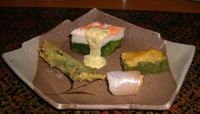 Many of you may have already discovered a variety of foods in Japan. Sushi is probably the most well known and admired cuisine in a lot of countries. Yakiniku, Yakisoba, or Ramen would be an alternative choice. However, I wonder if you ever had an authentic Japanese cuisine called Kaiseki. If you travel somewhere in Japan and stay at traditional Japanese hotels -- Ryokan, their serving dinner could be a great example. Kaiseki is worth trying and will be an amazing experience, which you could only experience in Japan.
Many of you may have already discovered a variety of foods in Japan. Sushi is probably the most well known and admired cuisine in a lot of countries. Yakiniku, Yakisoba, or Ramen would be an alternative choice. However, I wonder if you ever had an authentic Japanese cuisine called Kaiseki. If you travel somewhere in Japan and stay at traditional Japanese hotels -- Ryokan, their serving dinner could be a great example. Kaiseki is worth trying and will be an amazing experience, which you could only experience in Japan.
There are basically two kinds of Kaiseki; however, they both are a course meal which is made up of one soup dish and three items. In the present day, Kaiseki is a form of art that balances the taste, scent, texture, appearance, and colors of seasonal fresh foods from the farm or local items. Cooked dishes are carefully presented on beautiful plates to enhance both the appearance and the seasonal theme of the meal. Dishes are aesthetically arranged and garnished, often with real leaves and flowers, as well as edible garnishes designed to resemble natural plants or animals.
It has evolved to include an appetizer, sashimi, a simmered dish, a grilled dish, and a steamed course, in addition to other dishes at the discretion of the chef like deep-fried items. 懐石 “bosom-stone” is supposed to be a simple course at the tea ceremony, where the host welcomes his guests. On the other hand, 会席 “a cuisine for get-together” is more likely a course meal at banquet, which is more commonly preferred by business or family gathering with alcohol involved.
Sample Order
Sakizuke: an appetizer similar to the French amuse-bouche.
Hassun: the second course, which sets the seasonal theme. Typically comprises of one kind of sushi and several smaller side dishes.
Mukozuke: a sliced dish of seasonal sashimi.
Takiawase: vegetables served with meat, fish or tofu; the ingredients are simmered separately.
Futamono: a "lidded dish"; typically a soup.
Yakimono: Broiled seasonal fish.
Su-zakana: a small dish used to clean the palate, such as vegetables in vinegar.
Hiyashi-bachi: served only in summer; chilled, lightly-cooked vegetables.
Naka-choko: another palate for a change; may be a light soup.
Shiizakana: a substantial dish, such as a hot pot.
Gohan: a rice dish made with seasonal ingredients.
Ko no mono: seasonal pickled vegetables.
Tome-wan: a miso-based or vegetable soup served with rice.
Mizumono: a seasonal dessert; may be fruit, confection, ice cream, or cake.
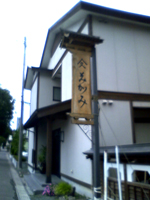 So, where can you find such a precious cuisine?
So, where can you find such a precious cuisine?
The closest and easiest-access from the main gate of Misawa Air Base would be the restaurant, "Mikami."
Just drive straight down from the main gate and turn right at the last traffic light. Across from Lawson, you will find this special restaurant on your right. Reservation is required at 0176-53-8154. It is open only 6pm ? 10pm, Monday through Saturday. The simplest course meal is available for 3,150 yen per person. That fills you up enough, but you may select an enhanced course meal with a higher price. The licensed master-chef serves blowfish cuisines during winter. I guarantee you a phenomenal experience.
No. 143 (7/10/09)
Climb Mount Fuji!
By Robert Finley
Chief Writer
When people think of Japan, the first thing they will probably associate with it is probably Tokyo, its capital and largest city, or the famous Mount Fuji (富士山), the country's largest and most famous mountain.
Standing at a whopping 3,776 meters (or 12,388 feet), Mount Fuji is a dominating feature on the Japanese landscape. Its famous image can be seen on a plethora of Japanese items and in Japanese company logos, and stands as a symbol of pride for the Japanese people.
Mount Fuji is one of the “Three Holy Mountains” (三霊山), along with Mounts Tate and Haku. Still an active volcano, Fuji's last eruption was sometime between December 16, 1707 and January 1, 1708, during what has been called the great Houei eruption, according to records (and it is considered at a low risk of eruption, so do not worry!). The mountain sits on the boundaries of Shizuoka and Yamanashi prefectures, just west of Tokyo. The cities Gotemba Fujiyoshia, and Fujinomiya surround the mountain, as do Lakes Kawaguchi, Yamanaka, Sai, Motosu, and Shoji. The mountain was formed where the Eurasian, Okhotsk, and Phillipine tectonic plates meet.
For many people, climbing Mount Fuji is a once in a lifetime experience that is very rewarding and something they will never forget. Indeed, it is a very popular activity, and it is very easy to find a guided tour to purchase, or even to find information on how to climb the mountain by yourself! But be warned, the climbing season is very, very short (usually running from July to August), and the climb itself is no easy stroll in the park -- the change in air pressure and elevation has been known to irritate climbers who try to sprint up the mountain. Climbers must be well-prepared and knowledgeable before they commit to climbing.
Here are a few tips for climbing Japan's greatest mountain (courtesy of japan-guide.com):
There are four 5th stations on different sides of the mountain, from where most people start their ascent to the summit:
Kawaguchiko 5th Station (located in Yamanashi Prefecture)
Altitude: about 2300 meters
Ascent: 5-7 hours
Descent: 3-5 hours
This is the most popular base for the climb to the summit, and the most easily accessible 5th Station from the Fuji Five Lake region and central Tokyo. The road to this 5th Station, the Fuji Subaru Line, is a toll road (2300 Yen), which gets closed to private vehicles during the peak of the summer holidays (August 7 to 18, 2009).
The Yoshidaguchi Trail leads from the Kawaguchiko 5th Station to the summit. Lots of mountain huts line the trail around the 7th and 8th stations, and there are separate trails for the ascent and descent. The sunrise takes place on this side of the mountain.
Subashiri 5th Station (Shizuoka Prefecture)
Altitude: about 2000 meters
Ascent: 5-8 hours
Descent: 3-5 hours
This 5th Station is located only at 2000 meters above sea level and is the base of the Subashiri Trail. The Subashiri Trail meets the Yoshidaguchi Trail around the 8th station.
Gotemba 5th Station (Shizuoka Prefecture)
Altitude: about 1400 meters
Ascent: 7-10 hours
Descent: 3-6 hours
This is by far the lowest 5th Station, and the ascent to the summit is accordingly much longer than from the other 5th stations. The Gotemba Trail leads from the Gotemba 5th Station to the summit. There are about four huts around the 7th and 8th station.
Fujinomiya 5th Station (Shizuoka Prefecture)
Altitude: about 2400 meters
Ascent: 4-7 hours
Descent: 2-4 hours
The closest 5th Station to the summit, the Fujinomiya 5th Station is the base for the southern approach via the Fujinomiya Trail. It is easily accessible from the railway stations on the Tokaido Shinkansen Line between Tokyo and Osaka. There are about half a dozen mountain huts along this trail.
The road to the Fujinomiya 5th Station is toll free and gets closed to private vehicles during the peak of the climbing season (July 15-17 and August 5-14, 2006).
Mountain Huts
The Kawaguchiko Trail is lined by more than a dozen mountain huts between the 7th and 8th station. Other trails have much fewer mountain huts. An overnight stay typically costs around 5000 Yen per person without and around 7000 Yen per person with two meals. During the peak, expect the huts to be extremely crowded. The Fuji-Yoshida City website (see below) lists phone numbers for reservations.
Climbing Equipment
Here is a list of essential climbing equipment:
* Hiking Shoes
The rocky, steep terrain in some sections and the potential of sudden, strong wind gusts are reasons to bring proper hiking shoes which protect your ankles.
* Proper Clothes
It can be below zero at the summit, and strong winds often make it seem even colder. Bring rain gear, as weather conditions can change very quickly in the mountains. Gloves are recommended both against the coldness and for hiking the steep, rocky passages.
* Flashlight
If you hike during nighttime, a flashlight is highly recommended in any season and essential outside of the peak season, when the trail is not illuminated by other hikers. Most people choose head lamps instead.
* Food
It is important to bring enough water and food. Mountain huts offer various meals and drinks. Be prepared to carry home all your garbage as there are no garbage bins on Mount Fuji.
Altitude Sickness
Quite a few people who climb Mount Fuji fall victim to altitude sickness. The human body requires some time to adjust to a sudden increase of altitude, otherwise there is a risk of headache, dizziness and nausea. To avoid altitude sickness, you are advised to tackle the mountain at a slow pace and make frequent breaks. An overnight stay at a hut around the 7th or 8th station is recommended as opposed to a straight climb to the top. Small bottles of oxygen, available at the 5th stations and mountain huts, can be an effective tool in preventing and fighting altitude sickness.
No. 142 (6/26/09)
Mini Computers
By Robert Finley
Chief Writer
In American culture, people are obsessed with what's new, what's hot, the latest gizmo or thing that is smaller, faster, and better than the previous one. Music playing devices have gone from giant phonograph players that doubled as a display shelf, to the iPod Nano over the course of just 50-60 years. Televisions, once also the dominant feature of a living room, are not just inches wide and can be hung on the wall like a picture frame. Telephones, too, have gone from bulky wooden boxes protruding out of the wall, to the tiny Star Trek-esque cell phones we have today. Americans, and indeed, much of the rest of the world, want the latest innovations to be smaller, lighter, more complex, and better performing than their predecessors. And why not? That’s how progress works.
But what about the personal computers? Most people are still anchored at their desks when it comes to their computers. Desktop computers, which are probably the most common style of personal computers, are (for the most part) big, bulky, and immobile. Even laptop computers, which are intended to be mobile, can be rather bulky and oddly-sized, making them diffi cult to travel with from place to place.
Rather new to the computer market is the mini notebooks or mini laptops, which are computers designed to save space while fulfilling your computer needs at an affordable cost. Consider these popular mini notebooks under $500, courtesy of PCWorld.com:
Acer Aspire One Mini-Notebook
Considering its bargain price of $349, the
Acer Aspire One is a steal ? until you realize
that you want the $100 six-cell battery. The
included three-cell battery lasted only 2 hours,
16 minutes in PCWorld.com'ss tests.
Acer's well-constructed, elegant entry is
roughly the same size as the Lenovo IdeaPad
S10. It weighs 2 pounds, about the same as the
tiny Dell Mini 9.
The Windows XP version has a 120GB hard
drive and an excellent keyboard. PCWorld.com's WorldBench
6 test results placed the Aspire One toward the back of the
Atom-based pack with a score of 34. The Windows-based
Aspire One did easily outpace HP's 2133, whose Via C-7M
CPU led it to an anemic mark of 26; but it fell well short of the Lenovo S10’s surprising score of 41.
A couple other issues with the Aspire One are a letdown.
The mouse buttons flank the touchpad, a design that can make
navigating documents diffi cult. A more minor issue is software
bloat: Our test system came preinstalled with a 60-day trial of Microsoft Offi ce, McAfee Security Center, and InterVideo's WinDVD. But overall, it’s a great bargain despite its few flaws.
Dell Inspiron Mini 9 Mini-Notebook
Dell's dainty Inspiron Mini 9 looks
as if someone left a standard laptop in
the dryer too long. PCWorld.com’s test
confi guration included an 8GB solid-state
drive stuffed with Windows XP Home and
preinstalled software such as Microsoft
Works; about 1GB remained free. You
should pay the extra $40 for an 16GB
drive.
In PCWorld.com's battery tests, the Mini lasted about 3 hours, 34 minutes with its four-cell battery. But
in PCWorld.com’s WorldBench 6 suite, the Inspiron Mini 9 mustered an abysmal score of 25.
If big keys are all you care about, this little laptop has incredibly oversize keys that make typing a breeze.
Here are some good tips for buying, also courtesy of PCWorld.com:
1. Know what you want to use it for and how much
you're willing to spend.
2. Buy a netbook with an 8.9-inch screen or larger.
3. Make sure you get a 6-cell battery for your netbook,
although you may have to pay $50 more and the
device will weigh more.
4. Try out the keypad and make sure it's right for you.
5. Software: see what it comes with and consider trying
the Linux OS.
6. Price: if it costs more than $500, start looking at a
regular notebook computer.
7. Look around at what's available.
8. And finally, the best netbook available
(according to PCWorld.com) is.... Acer's Aspire
One (see above for more information)
The market just keeps on growing for these
little laptops. If you need something that travels
easy and is relatively durable, this is what you
are looking for.
(Information from http://www.pcworld.com was
used in this article)
No. 141 (6/12/09)
Komakko Land (a Horse Park in Towada)
By Nao H. Kauffman
Chief Editor
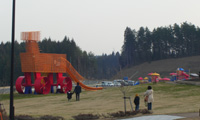 While Misawa is a city of aviation, Towada is one of horses. On the way to the Lake Towada and Michinoeki-Road Stop Oirase Roman(ce) Park, there is a large park called Komakko Land ). The park opened a few years ago, in honor of these majestic animals. The facility consists of a museum, ranch, and a playground. Although the museum Shotoku-kan has been in Towada for several years, the ranch and playground are new additions. Pets are not allowed for safety purposes. To barbeque within the park, you may want to call the office (0176-20-6012) in advance to reserve and arrange your spot. There is spacious room for playing catch or soccer near the playground.
While Misawa is a city of aviation, Towada is one of horses. On the way to the Lake Towada and Michinoeki-Road Stop Oirase Roman(ce) Park, there is a large park called Komakko Land ). The park opened a few years ago, in honor of these majestic animals. The facility consists of a museum, ranch, and a playground. Although the museum Shotoku-kan has been in Towada for several years, the ranch and playground are new additions. Pets are not allowed for safety purposes. To barbeque within the park, you may want to call the office (0176-20-6012) in advance to reserve and arrange your spot. There is spacious room for playing catch or soccer near the playground.
The museum features exhibits explaining the animal'shistory as a deity of sorts. The displays tell how the creature was worshipped as a holy being and as a dependable agricultural force. Toys of horse figures from all over the world are also displayed.
Visitors may feed carrot sticks to the baby horses presiding on the one-acre ranch for a small fee of yen. Short horseback riding within the ranch with a leash on, or carriage rides around the park, are available. There is also a small pony that likes to be taken out for a walk. You can pay the fees at the ticket counter in front of the ranch. The stable is free to enter and view the horses up-close.
Near the playground, there are two separated roller slides, altogether 713-ft. long. I strongly recommend picking up a mat from the bottom side for you to sit on at the top of the slide. There is a small storage room filled up with mats near the bottom side; however, there is none at the top. So, please be careful. You can burn your bottom by going too fast! The playground also has a 28-ft. high horse-shaped large slide called UMA (You-Ma) and a gigantic play gym for children. Moreover, near the beautiful flower garden (Spring- Fall), there is a smaller play gym for babies and tots.
A restaurant is open between 9am and 4: 30pm (April 1- November 30). However, the menu selections are very limited, such as pork curry, spaghetti, Udon and Soba noodles, fried chicken or links. 250-yen milky ice cream is irresistible in the summer.
Admission: Free to enter the playground and ranch (Closed: Mondays, December 29-January 3 for Near Year's)
Time: 8:30 a.m. - 6:00 p.m. (Apr. thru Oct.)
8:30 a.m. - 5:00 p.m. (Nov. thru Mar.)
*The museum charges 300yen for adults, 100yen for middle and high school students.
Hours: 9:00 a.m. - 4:30 p.m. all year around.
No. 140 (5/22/09)
Vertu
By Nao H. Kauffman
Chief Editor
When I was a student, a lot of people started using cell phones. Nowadays, it is harder to find someone who does not have a cell phone anywhere in Japan or the US. Some require cell phones for business, and others enjoy them for their conveniences. Many parents may give their children cell phones for their children's safety. As you known, cell phone industries were lead by Japanese mobile phone companies about 10 years ago. Still now, Japanese cell phones would have distinct styles, features, and functions compared to any other countries. For instance, the Japanese can use their cell phones for debit payment, train passes, banking, or stock trading etc. You could say people are addicted to cell phones. Therefore, many foreign mobile phone companies have been competing and catching up with such a unique innovation. NOKIA was one of them, which has a large market in North America and Europe.
To differ cell phones as luxurious items from regular handy items, Nokia has started their new subsidiary brand called Vertu by innovating British wealthy craftsmanship. Vertu is organized by 450 employees with 400 stores and 80 patents in 50 countries. Vertu Ginza Shop was finally opened last year. Ginza is a famous shopping area in Tokyo like Fifth Avenue, Rodeo Drive, or Champs-Elysees. Vertu was started by a simple concept from a British craftsman -- why not make a cell phone with the finest materials instead of plastics? In short, BMW, Ferrari or Rolex etc. are high-class people’s status items. Vertu holds three collections within the last decade by using sapphire crystal, gold, platinum, diamond, titan, leather and so on. They are all hand-made by well-trained craftsman in England. The price is from about $6000 up to $60,000. Unbelievable! The worst economy crisis is hitting the world, and people are living with debts or bonus cuts. Nevertheless, it is none of their business for Vertu and their users. Vertu is through NTT Docomo services, but many of Japanese cell phone useful functions are not available since they carry their own package programs. Yet, their distinctive characteristic, which comes with the expensive monthly bill, is the 24/7-concierge service. By pushing the concierge key, 22,000 top tables, 8000 hotels, 5000 flights, and even an elephant can be available for the users. The bottom line is they will answer your request, no matter what it is. It is ridiculous, but believe it or not, it is a true story. One customer asked for an elephant, and the Vertu concierge took care of it "sweet as a nut!" Would you think it is a smart purchase?
No. 139 (5/08/09)
祝!The 5th Anniversary Event for Misawa's Thai Restaurant
Belly Dance Performances
Sponsored by the Global Kitchen
By Nao H. Kauffman
Chief Editor
 Last summer, Misawa's Thai restaurant, Global Kitchen, celebrated their 4th anniversary by holding a large Thai festival with a variety of Asian dishes, unique items, shows etc. For their 5th anniversary event, they are going to throw an exotic belly dancing performance featuring the belly dance artist and instructor, Kabira. The event will be held on June 27th, Saturday, for the dinner show -- 4,500 yen (premier seats) include a full course of plated meal service and all you can drink and 3,500 yen (standard seats) which will be upper level and the view could be very limited. Kabira and her crew will perform around your tables. The dinner show is adults only (age 18 and over) for safety reasons since they use candlelights and swords throughout their shows. Reservations for purchasing the dinner tickets are required. Doors will open at 6pm.
Last summer, Misawa's Thai restaurant, Global Kitchen, celebrated their 4th anniversary by holding a large Thai festival with a variety of Asian dishes, unique items, shows etc. For their 5th anniversary event, they are going to throw an exotic belly dancing performance featuring the belly dance artist and instructor, Kabira. The event will be held on June 27th, Saturday, for the dinner show -- 4,500 yen (premier seats) include a full course of plated meal service and all you can drink and 3,500 yen (standard seats) which will be upper level and the view could be very limited. Kabira and her crew will perform around your tables. The dinner show is adults only (age 18 and over) for safety reasons since they use candlelights and swords throughout their shows. Reservations for purchasing the dinner tickets are required. Doors will open at 6pm.
Then on June 28th, Sunday, the lunch buffet will start at 11:30am, for adults 2,500 yen and for children (age 4 and over) 1,050 yen. The tickets are also on sale on a first come-first serve basis; however, you can get the tickets at the door as long as the seats are available. The show time schedules may be subject to change, so please call at 0176-57-3955 and see their advertising on the map below. Kabira has taken workshops with Veena and Neena, Ansuya, and Alexandria King over the years. She primarily learned and improved her dance techniques and styles from an instructor that resided part-time in Turkey. During this time she learned both Turkish and ATS elements of dance. Kabira has also spent time in Las Vegas with instructors improving difficult stomach undulations and flutters. She currently continues taking workshops and studies periodically with other dancers in Japan to inspire and improve her techniques. Kabira has a masters degree in counseling and has found this dancing to be both spiritual and nurturing to women’s bodies and minds. It is called "a woman's dance" for a reason.
Kabira's dances and costuming are influenced by her travels to different cities and countries. She has learned movements from her contact with dancers at festivals or dance workshops she visits while living or traveling in even remote places. She has been influenced by native tribes and folkloric dance movements from her encounters with the people's of Australia, Borneo, Bangkok, Costa Rica, Seoul, Singapore, Japan and Taiwan to name a few. Kabira also incorporates some tribal pieces into her costuming from her travels.
Kabira has included in her performances Egyptian Raks Assaya (cane) and Egyptian Raks Shamadan (candelabra). She is also able to perform exciting sword dances as well as wings and zills. She has performed at events such as festivals, fairs, weddings, rock bands, fusion Middle Eastern bands and restaurants both in U.S. and overseas. This could be something new to Misawa. Enjoy the unique ambience.
No. 138 (4/24/09)
the Insider's Picks
Handkerchiefs & a Bag-in-Bag
By Nao H. Kauffman
Chief Editor
Christmas and Valentine's Day are over. Ladies, did you receive your wish list items? I bet men are relieved that your mission was nicely done. However, you probably cannot relax because there will still be anniversaries, birthdays and Mother's Day coming up. Living in Misawa could limit your selection for gifts to your loved ones. People probably tend to go online or try to find some items locally. Generally, women love shoes and bags. Some people would say we cannot live without them! Have you checked out Coach purses or any other cute bags, even though you purchased or receive a nice bag? It's just fun, and we cannot help it.
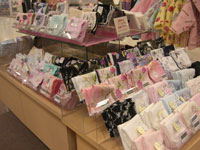 To add an accent to your personal item, I would like to recommend two things. These can be helpful ideas for men who cannot pick out gifts for ladies. First, handkerchiefs are pretty reasonable; the price range is 500-1,000 yen or more, with colorful prints and many different materials. You can find these items in AEON Shimoda Mall. Keeping a handkerchief handy in your bag is a woman's etiquette in Japan. Not only drying your hands after washing them, but also having a handkerchief can be handy in many situations and is good for the environment.
To add an accent to your personal item, I would like to recommend two things. These can be helpful ideas for men who cannot pick out gifts for ladies. First, handkerchiefs are pretty reasonable; the price range is 500-1,000 yen or more, with colorful prints and many different materials. You can find these items in AEON Shimoda Mall. Keeping a handkerchief handy in your bag is a woman's etiquette in Japan. Not only drying your hands after washing them, but also having a handkerchief can be handy in many situations and is good for the environment.
Next is an item called "a Bag-in-Bag." One well-known brand, Very Intelligent Pocket by Tintamar is originally from France. The bag can contain all of your essentials and can be moved from one handbag to another. In one go, you can select your handbag but the portable items such as cell phones, wallets, iPod etc. remain in the same bag. In short, the bag turns your handbag chaos into a functional fashion. You can purchase this item in different colors and sizes. Go on ebay.com and search the item with the key word, "Very Intelligent Pocket." You may also be able to find similar items at a travel shop or the bag section at the mall.
No. 137 (4/10/09)
Preserved Flower Arrangement
Flower Workshop "Nature"
By Nao H. Kauffman
Chief Editor
 Does giving a bouquet of flowers seem a cliche? Those flowers are beautiful, but they will not last long. Wouldn't that be nice if flower gifts could last for years and bring you back to the moment when you give or receive them? There are items called preserved flowers in Japanese markets. Generally, they are available at the most flower shops or online. The price is from about 3,000 yen.
Does giving a bouquet of flowers seem a cliche? Those flowers are beautiful, but they will not last long. Wouldn't that be nice if flower gifts could last for years and bring you back to the moment when you give or receive them? There are items called preserved flowers in Japanese markets. Generally, they are available at the most flower shops or online. The price is from about 3,000 yen.
The preserved flowers have started at the company, Vermont in France. Instead of drying the flowers for preservation, they select the freshest and finest flowers (mostly roses) and make them last almost forever by removing the original natural colors and dying them with the organic special colors. With this method, your deep love for flowers and greens can keep their beautiful shapes and colors. Then, there are other companies called Verdissimo and Florever as whole sellers followed after Vermont, and they still now improve the color options and increase the kinds of flowers for your conveniences. This innovative business hit Japan through the company called Ochi Nouen in 2003. Nowadays, they are admired as a variety of wonderful gifts or bridal items in the floral markets throughout Japan.
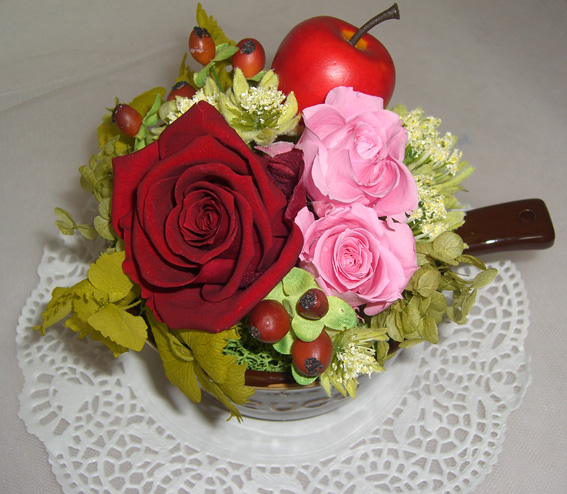 You probably now think what a great idea it is to put a sweet accent for your home or give these your friends or families as special gifts. Wouldn't that be nicer or more thoughtful if you can arrange on your own or customized your order within your budget? Such a special experience and services can be offered by a licensed instructor, Emiko Watanabe at the flower workshop, Nature in Misawa. The shop name originally was derived from a German language since she learned the German style of flower arrangement. Her career was based in Yokohama as a fresh flower designer and a mom for three children. As soon as preserved flowers started growing the business throughout Japan, she studied the arrangement technique and obtained an instructor license. She has various experiences with many seminars and workshops.
You probably now think what a great idea it is to put a sweet accent for your home or give these your friends or families as special gifts. Wouldn't that be nicer or more thoughtful if you can arrange on your own or customized your order within your budget? Such a special experience and services can be offered by a licensed instructor, Emiko Watanabe at the flower workshop, Nature in Misawa. The shop name originally was derived from a German language since she learned the German style of flower arrangement. Her career was based in Yokohama as a fresh flower designer and a mom for three children. As soon as preserved flowers started growing the business throughout Japan, she studied the arrangement technique and obtained an instructor license. She has various experiences with many seminars and workshops.
 Why in Misawa? Due to her husband's job, she moved up here last June and left her grown-ups in order to support her husband and enjoy her new life with him. She started learning English and found new friends through Misawa International Center. With the high demands and advice from her friends, she decided to work from home and opened her workshop last September. She still commutes to Yokohama once a month to offer her workshops and visits her family. The workshop is very reasonable and easy to try since she provides all the supplies such as glue guns, wires, preserved flowers and greens with some artificial materials. The trial lesson is 2000yen for the first-time only. She can also provide more samples and ideas to take the next lessons. The lesson fees are 1000 yen per one workshop and require the costs for materials, which are from 2,000yen. She will be offering some gift options for Mother's Day gifts from April 10th. (Early reservation is recommended for limited materials.) In fact, I am taking her April workshops after the trial (shown the photo) to do my projects. I would love to assist her as an interpreter while I am working on my projects if you visit her place on Wednesday. You may check out the photos of her and her students' works here (JP only). Please note that her English is very beginner. Email is the best way to contact her: sehkk5(at-mark)coffee.ocn.ne.jp. For those of you, who are not very crafty, trust me! It is very simple. She will also take orders for gifts within your budgets. Just pinpoint your budget and your loved one’s favorite color. She can help you pick a gift and create one by giving some ideas from her catalogs. For the access, please check the map. You can park your car in the unpaved area. The shop is closed on Tuesday, Sunday or Japanese national holidays.
Why in Misawa? Due to her husband's job, she moved up here last June and left her grown-ups in order to support her husband and enjoy her new life with him. She started learning English and found new friends through Misawa International Center. With the high demands and advice from her friends, she decided to work from home and opened her workshop last September. She still commutes to Yokohama once a month to offer her workshops and visits her family. The workshop is very reasonable and easy to try since she provides all the supplies such as glue guns, wires, preserved flowers and greens with some artificial materials. The trial lesson is 2000yen for the first-time only. She can also provide more samples and ideas to take the next lessons. The lesson fees are 1000 yen per one workshop and require the costs for materials, which are from 2,000yen. She will be offering some gift options for Mother's Day gifts from April 10th. (Early reservation is recommended for limited materials.) In fact, I am taking her April workshops after the trial (shown the photo) to do my projects. I would love to assist her as an interpreter while I am working on my projects if you visit her place on Wednesday. You may check out the photos of her and her students' works here (JP only). Please note that her English is very beginner. Email is the best way to contact her: sehkk5(at-mark)coffee.ocn.ne.jp. For those of you, who are not very crafty, trust me! It is very simple. She will also take orders for gifts within your budgets. Just pinpoint your budget and your loved one’s favorite color. She can help you pick a gift and create one by giving some ideas from her catalogs. For the access, please check the map. You can park your car in the unpaved area. The shop is closed on Tuesday, Sunday or Japanese national holidays.
No. 136 (3/27/09)
Highway tolls to be 1,000 yen by installing ETC
By Chiho Tsukiashi
Staff Writer
Is hitting the bars in Roppongi your ultimate leisure? Are you planning to take your family to Tokyo Disney World? Do you like to travel around and explore what Japan has to offer during your stay in Misawa? You bet! But those who are deployed here must drive long distances to reach a lot of the attractions in Japan, and many complain that the expensive highway tolls are a “pain in the neck.” What can we do? -- Installing ETC in your car is a major solution to the problem. It gives you up to 50% toll discounts. From March 28, the discount rate is going to be even bigger: 1,000 yen to anywhere you go during the weekend! This offer is too good to pass up! It’s expected that car accessory shops will be busy installing ETC device due to this new discount rate introduced. Learn about ETC now and get ready to take advantage of this opportunity.
What is ETC?
ETC stands for Electronic Toll Collection System. It
enables you to drive through highway toll gates without
stopping. Gate antennas and the ETC device installed in
your car exchange information wirelessly and tolls are
automatically charged to your credit card, which is inserted
in the device. To encourage drivers to get ETC services,
they offer various discount services.
Benefits of installing ETC
There are many advantages to installing ETC in your
car. First, you don't have to wait in a long line in front of
the exit gate. All you have to do is slow down to 20km/h
as you go through the gate with the purple“ETC”sign.
(Otherwise, the gate won't open and you will end up
breaking the bar and being charged a few thousand dollars!)
Secondly, avoiding such traffic jams is also efficient on
gas because it helps you drive smoothly without having
to step on the gas excessively. This also contributes to
limiting carbon-dioxide emissions into the air. Lastly, you
can save a lot of money, but you have to know how to take
advantage of the benefits.
New Discount Rate
From March 28, it costs only 1,000 yen to go anywhere on
Saturday, Sunday and Japanese holiday if you have ETC
installed. On weekdays, you'll get 30% off from the regular
toll. Note that there are some limitations on this discount
rate: It is not applicable for some highways in Tokyo and
Osaka. Plus, if you go through the metropolitan areas, you
will be charged another 1,000 yen till ETC system is fully
adjusted in the end of April 2009.
Various discount plans are available on weekdays as
well. Combine them to get maximum benefi ts. Beware that
the Michinoku Toll Road to Aomori is NOT a highway, so
the ETC service is not available there.
How to Get Started
1. Obtain ETC credit card
You will have to apply for a credit card with ETC function
to get started. Citibank’s “Citi ETC Card” is an option. Go
to CitiBank website (English)
for details. The card is not transferable, but the cardholder
can use it with any car with an ETC device. Tolls are
automatically charged as you go through the toll gates, and
the bills are sent to you from the card company.
2. Buy and install ETC device
An ETC device cost between 10,000 and 20,000 yen
including installation fees at car dealers or auto parts shops.
In Misawa, you can get it at Go Motors, for example. Used
devices are not available yet.
3. Setup
You will have to register your vehicle information in the
ETC device. This means you can not share the device with
another car. The registration must be done at the shop.
No. 135 (3/13/09)
Japanese Snacks, Candies and Cookies
By Chiho Tsukiashi
Staff Writer
Snacks, candies, and cookies… It’s hard to pass those isles in Japanese grocery stores with colorful packages with mouth-watering pictures on them. Usually they are eloquent enough to help you with what to choose and they don't betray your expectations. You might already have found your favorite. Here are some that a lot of Americans told me they love. If you haven’t tasted any one of them, please do so and you’ll want to store them in your kitchen counter.
1. Snacks
Some Japanese snacks have distinct flavors such as salty plum, seaweed, shrimp, and others that you might not be familiar with. Here are some examples that you would want to try.
・Potato Chips (Calbee)
 Among a variety of Calbee’s potato chip flavors, salt and consomme are most selling. They are almost addictive and it’s hard to stop eating once you bite the first chip. Compared with fried potato chips in the U.S., they are less oily and salty. Orange package is for salt, and yellow package is for consomme.
Among a variety of Calbee’s potato chip flavors, salt and consomme are most selling. They are almost addictive and it’s hard to stop eating once you bite the first chip. Compared with fried potato chips in the U.S., they are less oily and salty. Orange package is for salt, and yellow package is for consomme.
・Curl (Meiji)
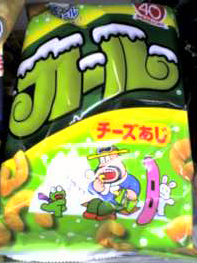 Puffed corn snacks with alphabet“C”shape. Cheese and curry are two flavors that appeal to Americans’ taste buds. Cheese Curl taste like Cheetos with a mixture of five different kinds of cheese. It’s a little milder than Cheetos. It comes in a green package. If you like curry, try Curry Curl in yellow package.
Puffed corn snacks with alphabet“C”shape. Cheese and curry are two flavors that appeal to Americans’ taste buds. Cheese Curl taste like Cheetos with a mixture of five different kinds of cheese. It’s a little milder than Cheetos. It comes in a green package. If you like curry, try Curry Curl in yellow package.
・Jagariko (Calbee)
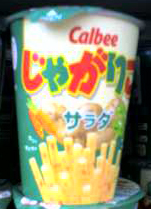 Crunchy potato sticks in a cup. The name comes from jagaimo, potato in Japanese. The more you chew them, the tastier they become! Salad, cheese, and potato with butter flavors are sold.
Crunchy potato sticks in a cup. The name comes from jagaimo, potato in Japanese. The more you chew them, the tastier they become! Salad, cheese, and potato with butter flavors are sold.
2. Candies
・Milky (Fujiya)
 Ball-shaped, milk-flavored caramel. Look for lovable Peko-chan character on package.
Ball-shaped, milk-flavored caramel. Look for lovable Peko-chan character on package.
・Hi-Chew (Morinaga)
 Fruit flavored chewy candy. Green apple, grape, strawberry, cantaloupe, pear, and other flavors are available. Each candy piece consists of outer white coating and colored, flavored interior.
Fruit flavored chewy candy. Green apple, grape, strawberry, cantaloupe, pear, and other flavors are available. Each candy piece consists of outer white coating and colored, flavored interior.
3. Cookies and Biscuit
・Country Mom (Fujiya)
 Most cookies sold in Japan taste similar to those in the U.S. Country Mom cookies are exception: They are soft as just out of oven! The secret of the softness is white azuki beans inside. You don’t want beans in cookies? Don’t worry. You’ll never notice they are inside unless you are told. Vanilla and chocolate are two major flavors, both containing chocolate chips. They taste even better if you microwave them a little.
Most cookies sold in Japan taste similar to those in the U.S. Country Mom cookies are exception: They are soft as just out of oven! The secret of the softness is white azuki beans inside. You don’t want beans in cookies? Don’t worry. You’ll never notice they are inside unless you are told. Vanilla and chocolate are two major flavors, both containing chocolate chips. They taste even better if you microwave them a little.
・Bisco (Glico)
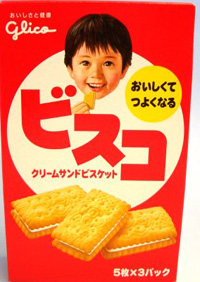 This has vanilla cream in between two little biscuits. Five biscuits contain 100 million lactic acid bacteria, which helps digestion. Also rich in Calcium, Vitamin B1, B2, D, it's an excellent treat for children and adults. Look for red box with a boy printed on it.
This has vanilla cream in between two little biscuits. Five biscuits contain 100 million lactic acid bacteria, which helps digestion. Also rich in Calcium, Vitamin B1, B2, D, it's an excellent treat for children and adults. Look for red box with a boy printed on it.
No. 134 (2/27/09)
Japanese Chocolate
By Chiho Tsukiashi
Staff Writer
You might be happy as long as Hershey's, Kit Kat, Reeses and Milky Way are available. But if you have a sweet tooth, it’s worth trying Japanese chocolate to broaden your horizons! Simple chocolate bars in Japan are, however, not much different from American ones. Here is a list of chocolate-coated or chocolate-infused products recommendable to anyone. They are available at any grocery store.
Almond Chocolate (Glico, Meiji, Lotte)
 Almonds coated with chocolate are standard items produced by major sweets companies. If you like malt puffs, choose Lotte Almond Chocolate Crispy, which contains puffs in the coating.
Almonds coated with chocolate are standard items produced by major sweets companies. If you like malt puffs, choose Lotte Almond Chocolate Crispy, which contains puffs in the coating.
Koeda (Morinaga)
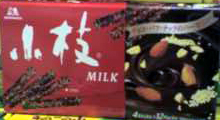 Koeda means twigs in Japanese. This chocolate is shaped like them. Contains crushed almond and malt puffs that give crispiness to it.
Koeda means twigs in Japanese. This chocolate is shaped like them. Contains crushed almond and malt puffs that give crispiness to it.
Shimi-choco Corn (Ginbis)
 Star-shaped corn puffs soaked up milk chocolate. Filling, ideal snack with calcium and fiber added. Received a *Monde Selection Gold Medal in 2004.
Star-shaped corn puffs soaked up milk chocolate. Filling, ideal snack with calcium and fiber added. Received a *Monde Selection Gold Medal in 2004.
Pocky (Glico)
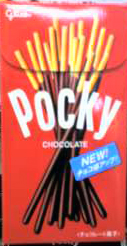 One of the internationally recognized Japanese snacks. Biscuit sticks coated with chocolate. It’s named after the Japanese onomatopoetic word for the sound made as you bite. Comes in many types of flavor, including regular (milk chocolate), Men's (bitter), strawberry, and almond.
One of the internationally recognized Japanese snacks. Biscuit sticks coated with chocolate. It’s named after the Japanese onomatopoetic word for the sound made as you bite. Comes in many types of flavor, including regular (milk chocolate), Men's (bitter), strawberry, and almond.
Koala no March (Lotte)
One-bite size cookies with chocolate filling inside. Cute pictures of koala are printed on cookies. Back in 1984, it started with 12 picture patterns with koalas playing musical instruments. The number of patterns increased and now there are over 300 types. Chocolate, strawberry, and milk flavors are available.
Takenoko no Sato (Meiji)
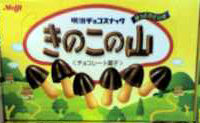
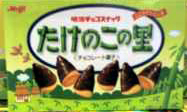 Shortbread cookies with thick creamy chocolate. They are shaped like bamboo shoots (takenoko). Similar product called “Kinokono Yama” from Meiji is also popular. This one is shaped like mushrooms. The stem is biscuit, and the cap is milk chocolate. Both items are tasty and fun snacks especially for children.
Shortbread cookies with thick creamy chocolate. They are shaped like bamboo shoots (takenoko). Similar product called “Kinokono Yama” from Meiji is also popular. This one is shaped like mushrooms. The stem is biscuit, and the cap is milk chocolate. Both items are tasty and fun snacks especially for children.
*Monde Selection
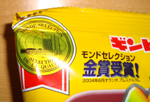 Monde Selection is a Belgian organization, which assesses food, sweets, alcohol beverages and other products from all over the world in terms of their taste, hygiene, ingredients, and accuracy of labels. Grand gold, gold, silver, or bronze medal is awarded to an entry. Although the organization accepts international entries, it’s hardly known in countries other than in Japan. Here, it has gained recognition that helps marketing award-receiving items especially produced by small companies which have to compete with large corporations.
Monde Selection is a Belgian organization, which assesses food, sweets, alcohol beverages and other products from all over the world in terms of their taste, hygiene, ingredients, and accuracy of labels. Grand gold, gold, silver, or bronze medal is awarded to an entry. Although the organization accepts international entries, it’s hardly known in countries other than in Japan. Here, it has gained recognition that helps marketing award-receiving items especially produced by small companies which have to compete with large corporations.
It's helpful to choose high-quality items if you look for Monde Selection labels on packages. They ensure tastiness and safety for consumption of the items.
*Small Tip
Department and grocery stores set up special section for chocolate before February 14. This is a perfect opportunity to buy grommet chocolates not only for your partner but for yourself.
No. 133 (2/13/09)
Hidden Natural Spring Water
By Nao H. Kauffman
Chief Editor
 Driving down Rt. 8 on the way to Shimoda Mall, you
will meet the road, that runs along the JR train tracks
toward Hachinohe. There is a small shop there that sells
fi ne natural homemade tofu and processed food items.
The place is called SENSUIAN (仙水庵.) They also
sell soymilk ice cream for 250 yen and freshly cooked
tofu doughnuts. Sometimes local farmers sell fresh
vegetables and fruits at this stand too.
Driving down Rt. 8 on the way to Shimoda Mall, you
will meet the road, that runs along the JR train tracks
toward Hachinohe. There is a small shop there that sells
fi ne natural homemade tofu and processed food items.
The place is called SENSUIAN (仙水庵.) They also
sell soymilk ice cream for 250 yen and freshly cooked
tofu doughnuts. Sometimes local farmers sell fresh
vegetables and fruits at this stand too.
 Delicious tofu requires a high quality of water;
in fact, their tofu is made from domestic soybeans
and natural spring water. Right next to the shop, is the
hidden natural spring water. This place is well known
to the locals and to some in Hachinohe. As a
matter of fact, I saw people in and out while
I was taking some pictures and had this
interview with the kind staff working that
morning. The water plant is open to the public
24/7. Surprisingly, it is free. So, you can bring
your empty jugs and take this fine water, and
as much as you want.
Delicious tofu requires a high quality of water;
in fact, their tofu is made from domestic soybeans
and natural spring water. Right next to the shop, is the
hidden natural spring water. This place is well known
to the locals and to some in Hachinohe. As a
matter of fact, I saw people in and out while
I was taking some pictures and had this
interview with the kind staff working that
morning. The water plant is open to the public
24/7. Surprisingly, it is free. So, you can bring
your empty jugs and take this fine water, and
as much as you want.
 I have known of this place since I came to Misawa Air Base. Although I have stopped by the shop to purchase tofu products several times, I have never cared about the
spring water until water supplies got cut off due to the
Hachinohe Water Company's accident on New Year's Day. Around midnight, my family and I noticed the odd occurrence of the water pressure was getting weaker. I immediately went online to check customer service and found out that we were not going to have any water for a few days. With all the concerns and anxious feelings, I was a little relieved because I knew free water was available there. So we drove down to get just enough water for the next day. After we purchased large water jugs, we also received water supplies from a water point in town. With spending troublesome and
the inconvenient start of the New Year, one night a cup of brewed coffee stroked my mind,“Something different?”I asked my mother if she used some different coffee beans. The answer was no. Then she told me that she made the coffee with the spring water from SENSUIAN because we could not use the tap water. Gradually, I started trying to use the spring water to cook rice and make tea or soup. I felt I had become a better cook. You will notice a big difference once you learn the fine taste of water; what is more, it is especially important for your good health. The chart in Japanese explains the standards of good water (mild alkalescent ion water); in short, it shows that natural spring water passed the standards and is even now recognized as fine drinking water: rich in minerals and calcium 58.2mg.
I have known of this place since I came to Misawa Air Base. Although I have stopped by the shop to purchase tofu products several times, I have never cared about the
spring water until water supplies got cut off due to the
Hachinohe Water Company's accident on New Year's Day. Around midnight, my family and I noticed the odd occurrence of the water pressure was getting weaker. I immediately went online to check customer service and found out that we were not going to have any water for a few days. With all the concerns and anxious feelings, I was a little relieved because I knew free water was available there. So we drove down to get just enough water for the next day. After we purchased large water jugs, we also received water supplies from a water point in town. With spending troublesome and
the inconvenient start of the New Year, one night a cup of brewed coffee stroked my mind,“Something different?”I asked my mother if she used some different coffee beans. The answer was no. Then she told me that she made the coffee with the spring water from SENSUIAN because we could not use the tap water. Gradually, I started trying to use the spring water to cook rice and make tea or soup. I felt I had become a better cook. You will notice a big difference once you learn the fine taste of water; what is more, it is especially important for your good health. The chart in Japanese explains the standards of good water (mild alkalescent ion water); in short, it shows that natural spring water passed the standards and is even now recognized as fine drinking water: rich in minerals and calcium 58.2mg.
You should defi nitely check this out. I bet you would appreciate this bountiful natural water.
No. 132 (1/23/09)
The New Filipino Restaurant in Misawa
By Ariane Sudo
Guest Writer
 "We’re not the first, but we're the best!" This is what the new R’ Bar and Restaurant is all about, only the best, nothing more, nothing less.
"We’re not the first, but we're the best!" This is what the new R’ Bar and Restaurant is all about, only the best, nothing more, nothing less.
The restaurant itself had been in the planning stages for over a year. The idea to deliver authentic Filipino dishes where everyone can come together to dine was driven by the local community's desire to have an alternative dining experience offered by local restaurants around the base. Be it at a friend’s party or in a regular restaurant in the U.S., the taste of Filipino food surely leaves a lasting taste in the pallet that keeps everyone wanting for more. R’ Bar and Restaurant opened in early November 2008. It offers a buffet line for a reasonable price, and it’s open daily from 11am until 8pm, except Sundays. Takeout is also available for your convenience, all you would have to do is just give them a call, and you can pick up your order in less than 30 minutes.
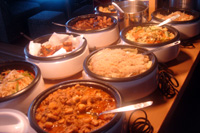 Upon entering the restaurant, there is no doubt that you can feel the Filipino hospitality of the staff. The manager of the place, a Filipina herself, is a great hostess who enjoys chatting with people, possesses a natural sense of humor, and is always ready and willing to attend to the customer’s needs. Although the restaurant set-up is buffet style, don’t hesitate to ask for additional assistance and she will gladly provide you a detailed explanation of everything you want to know about the menu.
Upon entering the restaurant, there is no doubt that you can feel the Filipino hospitality of the staff. The manager of the place, a Filipina herself, is a great hostess who enjoys chatting with people, possesses a natural sense of humor, and is always ready and willing to attend to the customer’s needs. Although the restaurant set-up is buffet style, don’t hesitate to ask for additional assistance and she will gladly provide you a detailed explanation of everything you want to know about the menu.
All time favorite Filipino foods available there includes Lumpia (spring roll), Adobo (a famous Filipino dish), and Pancit (stir-fried noodles). The selection of Filipino dishes varies everyday so you can dine there everyday of the week and your taste buds will surely be satisfied with variety. With home grown fresh vegetables handpicked from the local supermarkets, poultry and meat products supplied from a local farm in Hachinohe City, herbs and spices shipped directly from the Philippines, all these ingredients scrumptiously come together to deliver to you the real taste of a native Filipino cuisine.
In charge of the kitchen is a Filipina grandma, who came from a family of experienced chefs. This is pretty evident in the manner and grace in which she prepares her specialties. Understanding fully well that she is ultimately the one responsible for her customers’ satisfaction, she magically applies her special touch and motherly secrets to make her preparation and presentation one to crave for over and over again. Her cooking background started from the Philippines and her special techniques developed from a long family legacy of seasoned chefs. Nanay Beng, as she is fondly known for, having been a caterer and a restaurant owner back home, brings her talent and cooking expertise in northern Japan to satisfy Misawa City’s craving for authentic “Pinoy” dishes.
The restaurant also offers catering services for all occasions. The interior decorations, soft wall color paintings, and cozy furniture sets the tone for a relaxing, comfortable and yet oriental dining experience. Originally done up by an aspiring amateur interior decorator, the restaurant strikes a balance between Japanese tradition and Filipino hospitality in the decor, warm welcome atmosphere is presented the moment you step thru the door. In addition, customers who like to show his/her singing talent can truly enjoy two big screen televisions streaming with the latest selections of songs from a karaoke song book. R’ Bar and Restaurant is conveniently located right outside the POL Gate. Customers are provided free parking spaces right next to the building. The main entrance offers a small patio with a covered deck for smoking customers.
If you have been putting off to experience this one-of-a-kind taste of Filipino cuisine, don’t wait any longer as your “Pagkaing Pinoy” R’ Bar and Restaurant has something to offer to everyone. Come out and bring a friend or make a new friend there, and be part of our extended family by taking your family to dine with us now. Please see our new sponsor's ad below for their business hours etc.
No. 131 (1/9/09)
Web shopping hot items
By Nao H. Kauffman
Chief Editor
The coldest season for Misawa has just started. For those of us who are living off base, you may have experienced some trouble with the housing styles and/or heating systems, depending on when they were built. Most of the new housing should have central heating systems run electronically or by kerosene; however, running those systems all day would end up with big bucks! If you were still living in the U.S. you'd do to Best Buy or some other appliance store, or even browse online for some comparison-shopping.
Here in Japan kakaku.com is well known and always handy to check products and reviews before you purchase items. You can even go directly to retail shops’web sites in to learn more about a specific product. Compared to big cities like Tokyo, you may not find much price competition due to the small local population. Although everything is mostly written in Japanese, it's still helpful to learn a new product's ranking and review. If you find a product at K's or Yamada Denki, always remember the product's model number and you should be able to find the item online.
Hot carpetsHumidifiers
Heaters
Another reliable retail site is www.joshinweb.jp by Joshin Denki Co., Ltd., which has their service centers in Osaka. This company offers free shipping for your purchase over 5,250 yen and some warranty options besides their membership point reward system. Here are my recommendations:
Avitelax Mini Fan Heater AMF 804S (2,680 yen) This item is suitable for a bathroom or a child's room as it quickly heats up the room. The adjustable temperature switch economically turns itself on/off once the heater reaches a certain temperature; what's more, this item has a tilt-over feature for safety.
Electrolax Panel Heater EPH12-RB (16,200 yen to 20,800 yen or more)
*No.1 from
kakaku.com
Toyotomi Far-Infrared Ray (FIR) Heater EPH-121-W(B) (25,800 yen)
These items work well in large spaces such as living rooms. In contrast to the compact size and slim design, the FIR effi ciently heats up the room. An added bonus is you don't have to worry about dryness compared to other type heaters. These items are safe and clean; in fact, there's no need to put the safety gate around it or worry about your young children getting burned!
SHARP the ceramic fan heater with humidifier HX-127CX-A (16,580 yen)
This heater also comes with a humidifier, making it better
for your throat. Other useful features include an auto filter cleaning, sterile filtration with ion, timer or accident prevention, etc.
Instead of running the central heating system for the
entire house, this product may be suitable for a main
bedroom giving you a good night's sleep.
Why not ask your Japanese friends or housing agents to help you look? Although we here at The Insider will not be responsible for any of your purchases, we would be happy to assist you! Please e-mail us at editor.insider(at-mark)gmail.com or visit us during office hours. (All the prices may subject to change.)
No. 130 (12/26/08)
Quick Stop - Konbini
コンビニ: Convenience stores
By Nao H. Kauffman
Chief Editor
 In Misawa, you mostly see LAWSON and a few of
Circle K or Family Mart within short distances. The
defi nition of a convenience store in the U.S. is slightly
different from the Japanese one. In the U.S., they are
usually located alongside busy roads. Most of them are
attached to gas stations. It is like a quick rest stop for
travelers.
In Misawa, you mostly see LAWSON and a few of
Circle K or Family Mart within short distances. The
defi nition of a convenience store in the U.S. is slightly
different from the Japanese one. In the U.S., they are
usually located alongside busy roads. Most of them are
attached to gas stations. It is like a quick rest stop for
travelers.
On the other hand, the Japanese convenience stores (abbreviated as KONBINI) are more like small supermarkets. They open 24 hours all the year round. You can purchase drinks, frozen foods, quick foods, snacks or magazines. Some KONBINI sell alcohol if you see a sign of liquor (酒) . Daily comodities are also available; for example, several cosmetics items, toiletries, or stationary etc. The price is a little higher than regular supermarkets or drugstores. Nevertheless, people cannot resist stopping by for the handiness. Then, there are also some limited items available. Additionally, courier/postal services, offi ce services (fax and photocopies), ATMs, bill payment services, and ticket services are available as well as purchasing merchandises.
 The winter specialty is freshly cooked ODEN or
NIKUMAN at the cashier. ODEN is mainly slowly cooked vegetables, fish cakes called SURIMI or sausages in the soup. NIKUMAN is originated to Chinese Dim Sum, stuffed
steam buns (picture right). Today, KONBINI offers different flavors
such as PIZZA-MAN, Curry-MAN, AN-MAN (sweet beans.) These items cost only 80-200 yen per item and quickly fi ll your stomach.
The winter specialty is freshly cooked ODEN or
NIKUMAN at the cashier. ODEN is mainly slowly cooked vegetables, fish cakes called SURIMI or sausages in the soup. NIKUMAN is originated to Chinese Dim Sum, stuffed
steam buns (picture right). Today, KONBINI offers different flavors
such as PIZZA-MAN, Curry-MAN, AN-MAN (sweet beans.) These items cost only 80-200 yen per item and quickly fi ll your stomach.
Once you get used to KONBINI in Japan, you would
probably fi nd the American convenience stores dull.
Here are some helpful words around the price lists.
新商品 SHIN SHOU HIN; new item)
お買い得 (OKAIDOKU; on sale)
限定品 (GENTEI HIN; limited item)
本日限り (HONJITSU KAGIRI; today only, no rain
checks)
見切り品 (MIKIRI HIN; close-out)
No. 129 (12/12/08)
Misawa City's Christmas 2008
By Nao H. Kauffman
Chief Editor
 The countdown to 2009 has already begun, and the holiday
season is just around the corner.
The countdown to 2009 has already begun, and the holiday
season is just around the corner.
Having Christmas in Japan must be a little different than usual since everyone is so far away from home.
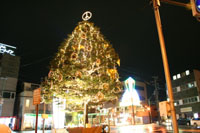 This will be a wonderful opportunity for you to have a very special Christmas that you would never experience in the US. At the newly opened American Park right off the main gate, Misawa city set up Christmas illuminations with an eight meter tall Christmas tree and a nine meter long tunnel made of pet bottles. The lights will be on during the Misawa city’s Christmas event: December 4th ? 25th.
This will be a wonderful opportunity for you to have a very special Christmas that you would never experience in the US. At the newly opened American Park right off the main gate, Misawa city set up Christmas illuminations with an eight meter tall Christmas tree and a nine meter long tunnel made of pet bottles. The lights will be on during the Misawa city’s Christmas event: December 4th ? 25th.
For all Japanese and American’s who live on and off-base ? Are you interested in volunteering? Are you musically inclined, and want to play in a band or have one on your own? Are you willing to teach culture and crafts? Are you willing to volunteer to work at fl ea markets and various shops? Then the new Misawa American Village is for you. We are looking for people who are motivated, interested and willing to participate in language and cultural exchanges. This is the chance of a lifetime to interact with Japanese and Americans alike. If you’re interested, please send an email to: mcci404(at mark)r66.7-dj.com. For more information, please check out their web site.
Furthermore, from December 3rd, Misawa city’s market street “White Pole Road”will be offering a great Christmas sale including lucky draw with great prizes; for example, 10,000 yen gift certifi cate. During the event, food vendors and shops are available.
T'ai chi and Kung Fu Demonstration
On December 7th (Sun) and 21st (Sun) from 1pm through 6pm, t'ai chi and kung fu will be demonstrated in American Park. You are welcome to join and experience them.
Apples on Sale
This year, hail damaged apples, the specialty of Aomori prefecture. Help farmers by buying them, which taste as good
as undamaged ones. They are sold at special discount price in American Park on December 13rd (Sat) and 14th (Sun). You are lucky to purchase the price down apples this year!
The Insider will be supporting the Christmas event. We will be updating our website with more current information on this event. Please check it out!
No. 128 (11/28/08)
"Range de Chin: Microwave Meals
By Nao H. Kauffman
Chief Editor


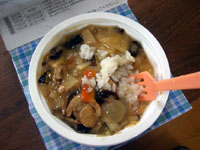
I hope the title caught your eye; it's a common Japanese phrase meaning to cook microwaveable foods or to heat your food in a microwave.“Range” comes from the words “Denshi Range”or a microwave.”“Chin” is the beeping noise the microwave makes when your food is ready. Instead of saying “Please heat up your food in a microwave,”simply say “Range de Chin.” It’s quicker and makes perfect sense here in Japan!
Microwavable foods have rapidly become the alternate food item instead of canned. In the U.S. the development of refrigerators and freezers brought a variety of frozen foods. The Japanese had to find alternatives in a different way as the diffusion rate of refrigerators and freezers were relatively behind. In short more pre-cooked meals had to be produced that could also be stored at normal room temperature. Pouched curry was a well-known item in 1960’s; soups, porridge, pasta sauce, and many other items soon followed. Nowadays, a large food manufacturer company called S&B Foods, Inc. has a great line-up in this market such as fried rice, risotto, doria, and spicy Korean dishes, etc. These items are easily found in any local supermarkets for about 200yen each. You can store at normal room temperature for months on end. Simply heat up for a few minutes in a microwave. I have seen similar products by Hormel and other companies at the commissary for a higher price! However, the taste and freshness of S&B products after heating are superb. These items are great and economical for lunch or a quick snack.
Instructions (next to picture):1. Open box and plastic lid to the dotted line, then open and pour attached package over food.
2. Close and seal the paper top; heat up with a microwave.
3. Carefully take out container from microwave.
4. Peel off the plastic and paper tops and mix contents. The bottom of the package can be used as a tray.
Enjoy!
No. 127 (11/14/08)
New UMUC Scholarship Fund will Aid Servicemembers, Spouses
$200,000 fund will buy textbooks for servicemembers, help pay tuition for family members.
Adelphi, Md. (Nov. 3, 2008) -- University of Maryland University College (UMUC) today announced a new scholarship fund earmarked to assist active-duty, enlisted servicemembers and their families.
The $200,000 fund will provide fi nancial assistance to UMUC’s military students ands their spouses in Asia, Europe and the Middle East, as well as stateside. It will cover the cost of textbooks for enlisted, active-duty members of the U.S. armed forces, as well as tuition assistance in the form of scholarships to spouses of enlisted, active-duty servicemembers. All awards will be need-based, renewable, and contingent upon the student maintaining satisfactory academic standing. The initial endowment will be disbursed over four years, but the fund will remain open to additional contributions.
"Given UMUC’s long history of service to members of the military and their families, we are especially proud to announce this new military scholarship fund,” said Dr. Susan C. Aldridge, president of UMUC. “It promises to lessen the fi nancial burden on our brave women and men in uniform?and their families?and bring them one step closer to earning a valuable UMUC degree that will open doors and broaden horizons for years to come.”
Currently, UMUC enrolls an estimated 60,000 military servicemembers, dependents and veterans each year. Under contract with the U.S. Department of Defense, the university is currently positioned to be among the fi rst institutions to offer classes face-to-face to servicemembers stationed on the ground in Iraq.
For more information, servicemembers and their spouses stationed in Asia may contact Michael Kulyk at mkulyk(at-mark)asia.umuc.edu; those in Europe may contact Edna Roy at eroy(at-mark)ed.umuc.edu.
About University of Maryland University College University of Maryland University College, h eadquartered in Adelphi, Maryland, is the second-largest university in Maryland, serving 90,000 students and offering 132 undergraduate and graduate programs online and on-site. In addition, UMUC is the second-largest public university in the United States and one of the largest public providers of online higher education in the nation. UMUC boasts a 60-year history of service to the military and currently enrolls an estimated 60,000 military servicemembers, dependents and veterans each year. The university offers face-to-face instruction at 21 locations throughout Maryland and educational services at more than 120 locations overseas, including the Middle East. UMUC is accredited by the Commission on Higher Education of the Middle States Association of Colleges and Schools and is a constituent institution of the University System of Maryland, an agency of the State of Maryland.
No. 126 (10/24/08)
Misawa's Genuine Bakery Shop
Cafe Matiere IKEZAKI
By Nao H. Kauffman
Chief Editor
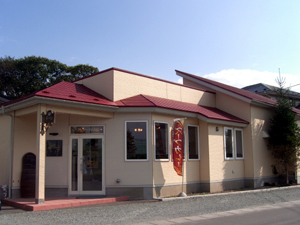
 After living in Canada and America for eight years, what I have longed for besides authentic Japanese foods was Japanese-French bakeries. As I grew up with having toasts or fresh pastries beside scrambled eggs, bacon, and fresh fruits for the weekend breakfast, in contrast to having
rice and miso soup before school, I was so tired of a box of cereals, chewy bagels, or thin bread with dull and not tasteful texture for the past eight years. My spouse always makes fun of how Japanese people tend to apply European things into the Japanese market, as he sees the French infl uences on many products in Japan. Yet I proudly believe that any bakeries around the corners in Japan are superior to the delis in the American supermarkets. I have seen a few chain American-French bakery shops in San Francisco or San Jose.
I would say certainly New York or any larger cities would have a quite a few. Nevertheless, it is nothing like the ones in Japan in terms of the quality and convenience. I assume most of you have wandered around the bakery section of the supermarkets such as Universe, JUSCO, or Maeda and have tasted something new for you. Now you should visit the fi ne bakery, Cafe Matiere IKEZAKI. After you leave Misawa for your next assignment, you would feel as I felt before. And then, you would never forget IKEZAKI.
After living in Canada and America for eight years, what I have longed for besides authentic Japanese foods was Japanese-French bakeries. As I grew up with having toasts or fresh pastries beside scrambled eggs, bacon, and fresh fruits for the weekend breakfast, in contrast to having
rice and miso soup before school, I was so tired of a box of cereals, chewy bagels, or thin bread with dull and not tasteful texture for the past eight years. My spouse always makes fun of how Japanese people tend to apply European things into the Japanese market, as he sees the French infl uences on many products in Japan. Yet I proudly believe that any bakeries around the corners in Japan are superior to the delis in the American supermarkets. I have seen a few chain American-French bakery shops in San Francisco or San Jose.
I would say certainly New York or any larger cities would have a quite a few. Nevertheless, it is nothing like the ones in Japan in terms of the quality and convenience. I assume most of you have wandered around the bakery section of the supermarkets such as Universe, JUSCO, or Maeda and have tasted something new for you. Now you should visit the fi ne bakery, Cafe Matiere IKEZAKI. After you leave Misawa for your next assignment, you would feel as I felt before. And then, you would never forget IKEZAKI.
Mr. Kota Ikezaki opened his own bakery shop in Misawa on April 27, 2007. The directions are: turn left at the T-section by Super Asahi Drug from the POL gate, and turn left again to follow the sign. You will see a small bakery with a red roof near junior high school. They are open from Monday through Saturday (7AM- 7PM.) From November 1, the shop will close at 6PM. After his high school graduation, Mr. Ikezaki started working for a hotel and found more interests toward patisseries, especially baking bread. Meanwhile, he found a position at one of famous bakeries called Mont-Thaor in Tokyo. He began dreaming about opening his own shop in his hometown. Over the last 10 years, he worked in Tokyo and moved to Sapporo to become the area manager. He has successfully learned the know-how of bakery business and many recipes. Unfortunately, due to his eye disease, he had to resign from his position, but was also offered to be a manager at the Jusco's previous bakery shop. With looking back his past busy life and working long hours, he realized it was the time to take a new step toward his dream. Thanks to all his family's support, he confi dently opened the best bakery in Misawa with fi ne qualities and delicious items. He happily smiled and told me that now he spends more time with his daughter, and they spend quality family time together on Sunday.


 His day starts at four in the morning for all the preparation. As the shop's name “Matiere” (French word meaning "material"), Mr. Ikezaki skillfully uses 13 kinds of fl ours to fi nd the best mixture for his recipes, of which he has over 40. All of his items have no preservatives or MSG for better natural tastes. The shop offers
a little cafe space and a bar counter with some beverages. It is suitable for a quick breakfast or lunch. His curry soup lunch set with Nan bread is well-known and limited only for the fi rst 20 customers. The top items are easily found by the ranking signs near the price cards. The current No.1 is Cheese Pumpkin Pie, which uses some cream cheese and Kabocha (Japanese squash) grown by his wife's parents in Misawa. He also passionately recommends his hamburger and French baguette. The burger's patty is featured with the meat shop IWAMA on the White Pole Road. Mr. Ikezaki and IWAMA's butcher studied and explored the best combination of beef and pork together. With a bit of Okinawa's special sea salt, Mr.Ikezaki believes it is the best of best.
He suggests reserving the burgers in advance since they get quickly sold out. Although I visited the shop early morning, I was surprised to see a variety of items on the shelves.
In a little while, his special French baguette was freshly baked. Hestated no one can buy baguettes so early anywhere else but at his shop in Misawa. H is croissant uses 100% fresh butter instead of using margarine. S ome of the French customers in Misawa gratefully admire his shop as much as the authentic French bakeries.
His day starts at four in the morning for all the preparation. As the shop's name “Matiere” (French word meaning "material"), Mr. Ikezaki skillfully uses 13 kinds of fl ours to fi nd the best mixture for his recipes, of which he has over 40. All of his items have no preservatives or MSG for better natural tastes. The shop offers
a little cafe space and a bar counter with some beverages. It is suitable for a quick breakfast or lunch. His curry soup lunch set with Nan bread is well-known and limited only for the fi rst 20 customers. The top items are easily found by the ranking signs near the price cards. The current No.1 is Cheese Pumpkin Pie, which uses some cream cheese and Kabocha (Japanese squash) grown by his wife's parents in Misawa. He also passionately recommends his hamburger and French baguette. The burger's patty is featured with the meat shop IWAMA on the White Pole Road. Mr. Ikezaki and IWAMA's butcher studied and explored the best combination of beef and pork together. With a bit of Okinawa's special sea salt, Mr.Ikezaki believes it is the best of best.
He suggests reserving the burgers in advance since they get quickly sold out. Although I visited the shop early morning, I was surprised to see a variety of items on the shelves.
In a little while, his special French baguette was freshly baked. Hestated no one can buy baguettes so early anywhere else but at his shop in Misawa. H is croissant uses 100% fresh butter instead of using margarine. S ome of the French customers in Misawa gratefully admire his shop as much as the authentic French bakeries.
The outstanding characteristic of Cafe Matiere is based on Mr. Ikezaki's pride and policy, which provides the fi ne taste and quality of the originalities. He simply wishes many people and children in his neighborhood learn the truly fi ne taste he creates. He mentioned the main season is Christmas for any bakery shops. He enjoys being busy and preparing for different seasonal menus before the holiday season. He is always willing to challenge unique recipes because each item has its own fans. Furthermore, he is eager to learn and develop his skills, so he sometimes tries to attend a few seminars held by top bakers. At last, he clearly delivered that he would like to do his best and continuously communicate with his customers by providing the best quality of his items. As one of his bakery's fans, please check it out!
Message from Cafe Matiere
“For the upcoming Beaujolais Nouveau release day, November 20, it is highly recommended that you reserve your
baguettes. We take your orders until a day before. Otherwise, we cannot guarantee the items since last year we quickly sold them out. Keep this in mind for Christmas or special occasion.”
No. 125 (10/10/08)
Going Live, Japanese Style
By Robert Finley
The Insider Chief Writer
One of the most popular pastimes in America is going to live performances. Whether it be plays, musicals, concerts, or something else, going out to see something in person is a fun and oftentimes an exciting way to break the monotony of daily life.
If you are new to Japan, however, you might not be familiar with some of the resources available to you so that you can fi nd out about upcoming events. Fret not! There are a lot of ways to fi nd out what’s going on and where. Here are a few to help you out:
SMASH-jpn.com is a great resource for fi nding ticketsto a wide variety of concerts and music festivals. It’ s not just Japanese musicians listed, either ? musicians from all over the world advertise their upcoming shows through SMASH-jpn.com. Anything you need to know is listed right there on the site, from location; time and date; ticket cost; and even musician bios.
Another great source for concert info is the Creativeman Web site at www.creativeman.co.jp. Here, you’ll fi nd a large number of American entertainers advertising upcoming tours here. And like SMASH-jpn.com, they have info on tickets, locations, and more.
Besides concerts, there are s ome other cool e vents throughout Japan, such as Design Festa. Design Festa is a bi-annual international art exhibit that began in 1994, where artists from all over the world come to display their artwork. It is the biggest exhibit of its kind in Asia, and averages about 7,000 exhibitors and 53,000 visitors. The event is held at Tokyo Big Sight (offi cially known as the Tokyo International Exhibition Center), Japan’s biggest event hall, which is located in Odaiba of Tokyo Bay, which is part of the Kanto region. The next Design Festa is scheduled to be held the weekend of Nov. 8-9, 2008, with hours 11:00 a.m. ? 7:00 p.m. Directions and all other pertinent information can be found at their Web site www.designfesta.com. The Design Festa Gallery, a smaller art exhibit that is open from 11:00 a.m. ? 8:00 p.m. and is free admission, has East and West exhibits located in the Harajuku district of Tokyo. For more info on this exhibit, check out their Web site.
These are just a few ways to fi nd some exciting and interesting events and live outings during your stay here in Japan.
(Information from http://www.smash-jpn.com, http://w ww.creativeman.co.jp, and http://www.designfesta.com was used in this article).
No. 124 (9/26/08)
What's new? Our hometown cafe シェモア
By Nao H. Kauffman
The Insider Chief Editor
 Cafe シェモア
Cafe シェモア
OPEN: 9:00 till 19:00
(Last order by 18:30)
CLOSED: SUN & HOLIDAYS
A brand new spot where you can enjoy your morning with freshly-brewed coffee and a grilled cheese sandwich, or meet up with your friends f or reasonable lunch special sets a nd follow with home-baked cakes or sweet parfaits; this is the place where you should be -- “Cafe シ ェモア ” known as “Chez Moi” in French, which sounds like “Che More.” It means “my home” in English. It is located in Oirase Town toward Michinoku Toll Road exit from the POL gate. You will see the small signs right after the Jam Friend Club pachinko or right before the “Dynam” pachinko near Circle K. It is built in a quiet residential area, section H, behind a small wood area.
 The cafe has been opened since July 2008 by the owners, who have been married for 16 years. Opening a cafe together after they retired was their dream. However, they changed their mind because they realized it is better to start the business when they are younger and enjoying their life together, and as the saying goes,
to “strike while the iron is hot.” At last, their dream has come true. The husband mainly manages taking orders while the wife is the certified chef at the cafe. She previously helped her parents who run a guesthouse in Misawa.
The cafe has been opened since July 2008 by the owners, who have been married for 16 years. Opening a cafe together after they retired was their dream. However, they changed their mind because they realized it is better to start the business when they are younger and enjoying their life together, and as the saying goes,
to “strike while the iron is hot.” At last, their dream has come true. The husband mainly manages taking orders while the wife is the certified chef at the cafe. She previously helped her parents who run a guesthouse in Misawa.
My friend ordered the loco-moco style hamburg steak, and I ordered the lunch special, which served freshly baked bread, a small soup and salad with a piece of quiche, in addition to a small complimentary dessert and juice, tea or coffee. All the lunch specials are served for 680 yen. They also offer monthly special chiffon cake (currently apple chiffon cake with diced apples) besides tea leaf chiffon cake, chocolate cake and cheese cake for only 200 yen (price subject to change).
 Once you walk into the cafe, the fresh wood scent of the newly built house gently hits your nose as if you were welcomed to your friend’s house. Then, the old-school, brown steel wood stove, with a black steel pipe up to the high ceiling, immediately jumps into
your sight. As the winter hits here, you will seem to be
at a ski resort lodge's to warm snugly in. My favorite part of this cafe is that they have a decent kid’s play area
with a white board and markers, a small TV with DVDs
and also a lot of books and toys. Many useful ideas were
brought into this wonderful cafe. For example, a hook to hang your purse is attached to the tables. Moreover, there are more seats available upstairs, which is great for PTA meetings or business meetings, etc. The party room
is also available by reservation. (Please stop by directly
t o this cafe for reservations and party arrangements since the owners are afraid of miscommunication over the phone, due to their poor English).
Once you walk into the cafe, the fresh wood scent of the newly built house gently hits your nose as if you were welcomed to your friend’s house. Then, the old-school, brown steel wood stove, with a black steel pipe up to the high ceiling, immediately jumps into
your sight. As the winter hits here, you will seem to be
at a ski resort lodge's to warm snugly in. My favorite part of this cafe is that they have a decent kid’s play area
with a white board and markers, a small TV with DVDs
and also a lot of books and toys. Many useful ideas were
brought into this wonderful cafe. For example, a hook to hang your purse is attached to the tables. Moreover, there are more seats available upstairs, which is great for PTA meetings or business meetings, etc. The party room
is also available by reservation. (Please stop by directly
t o this cafe for reservations and party arrangements since the owners are afraid of miscommunication over the phone, due to their poor English).
This place just meets your desires, especially for moms with little ones, who have no where else to go but McDonald’s; it is somewhere you can relax, or just want to get out of your house to do something different. An English menu is also available. To be honest, I wanted to keep this a secret since it is near my house. However, I wish great success to the owners and would like to thank them for making such a unique place. I promise you would feel like you are right at home. Please check it out! (http://www14.ocn.ne.jp/~chezmoi/index.html) *Colored pictures are available on their web site. Please note that the phone number is only for Japanese services. The owners w ould appreciate y our contacting them in person at the cafe.
No. 123 (9/12/08)
Beautification and Friendship Project of Misawa Air Base and the Misawa Community
By Arisa Brown
The Insider Staff Writer
 A project is currently in progress on White Pole Road in order to promote friendship between Misawa Air Base and the Misawa city community. Headed by the Chamber of Commerce and Industry of the Japanese community, efforts are being made to beautify the shutters of the many shops along White Pole Road. The project is being split into four sections. Of these four, the Omachi town district’s efforts are being headed by Mr. Baba, the Market Street Department of Development coordinator. Mr. Baba is working with The Insider, a number of volunteers from on and off base, and alongside storeowners to coordinate a joint effort where children from the Fun and Learning Center off base and children from the Lunney Youth Center will work together to paint the shutters.
A project is currently in progress on White Pole Road in order to promote friendship between Misawa Air Base and the Misawa city community. Headed by the Chamber of Commerce and Industry of the Japanese community, efforts are being made to beautify the shutters of the many shops along White Pole Road. The project is being split into four sections. Of these four, the Omachi town district’s efforts are being headed by Mr. Baba, the Market Street Department of Development coordinator. Mr. Baba is working with The Insider, a number of volunteers from on and off base, and alongside storeowners to coordinate a joint effort where children from the Fun and Learning Center off base and children from the Lunney Youth Center will work together to paint the shutters.
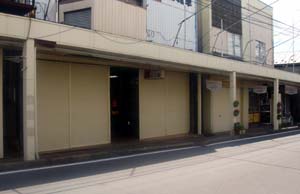 Designs for the project will be created by painter, graphic designer, and artist Claire Wentzel. A graduate from the University of Colorado at Boulder, Claire holds a Bachelor of Arts degree in studio art (painting emphasis), and a minor in geology. Claire has experience with a variety of art-orientated projects in multiple medias, such as the I Madonnari Italian Street Painting Festival, held annually in Santa Barbara, Ca., and the Chalk La Strada in San Diego, Ca. Claire has been stationed in Misawa city with her husband for two years, and has also participated in numerous events and volunteer projects on base. Recently, she has been working on capturing the scenic beauty of Misawa and other interesting aspects of the Japanese culture through photography. With her many talents and interests, it will be exciting to see her contribution to this project.
Designs for the project will be created by painter, graphic designer, and artist Claire Wentzel. A graduate from the University of Colorado at Boulder, Claire holds a Bachelor of Arts degree in studio art (painting emphasis), and a minor in geology. Claire has experience with a variety of art-orientated projects in multiple medias, such as the I Madonnari Italian Street Painting Festival, held annually in Santa Barbara, Ca., and the Chalk La Strada in San Diego, Ca. Claire has been stationed in Misawa city with her husband for two years, and has also participated in numerous events and volunteer projects on base. Recently, she has been working on capturing the scenic beauty of Misawa and other interesting aspects of the Japanese culture through photography. With her many talents and interests, it will be exciting to see her contribution to this project.
Currently, the dates for the project will be on Sep. 10, 11, and 12, with one painting session in the morning and a second starting at 3:30 p.m. Snacks and drinks will be provided; however smocks will not, so please bring your own painting clothes. All are welcome to participate. If you have any questions about the event, please call 0176-52-6672 for both English and Japanese speakers.
No. 122 (8/26/08)
Hair Salons in Our Town
By Nao H. Kauffman
The Insider Chief Editor
Thanks to these salons for being our great sponsors, I would like to introduce three hair salons, two in Misawa and one in Oirase. Among the many hair salons off base, The Insider strongly recommends the following hair salons, with reasons:

PRISM
First, PRISM is well known in Misawa, and located near the POL gate. This hair salon seems to be experienced and is always busy with locals and people from base. The salon is particularly vibrant because of its many skilled staff members, who are always prepared. If you are a newcomer, you can ask for an appointment with the owner, Mr. Yamamoto, who is bilingual and has had a long career in the business. There are five other bilingual stylists available at this salon, however. A great feature of this salon is that walk-ins are accepted. They do their best to smoothly serve you. If you would like to get your hair done within a certain time, it is best to make an appointment in advance with a stylist.*The following comment is by PRISM’s 3-year loyal customer , Mrs. R. M.*
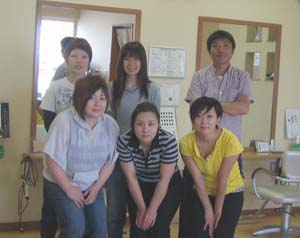 "I like PRISM because the energetic staff always frankly greet and welcome their customers. Once you request what kind of hairstyle you wish, your stylist honestly explains how she or he will proceed, and how your hair will look when it’s done. Your stylist answers any questions you have about hairstyles, especially when you want to try something new. The stylists give great advice about what’s best for you. Your stylist will show you the total price before she or he starts, so you can just relax. Your stylist teaches you how to take care of your hair and how you can style your hair at home. Therefore, you can always easily keep your hairstyle as close to the way it was when you left PRISM. So far, I have probably recommended this salon to 10 of my friends!
"I like PRISM because the energetic staff always frankly greet and welcome their customers. Once you request what kind of hairstyle you wish, your stylist honestly explains how she or he will proceed, and how your hair will look when it’s done. Your stylist answers any questions you have about hairstyles, especially when you want to try something new. The stylists give great advice about what’s best for you. Your stylist will show you the total price before she or he starts, so you can just relax. Your stylist teaches you how to take care of your hair and how you can style your hair at home. Therefore, you can always easily keep your hairstyle as close to the way it was when you left PRISM. So far, I have probably recommended this salon to 10 of my friends!
Pay Forward-YUI-
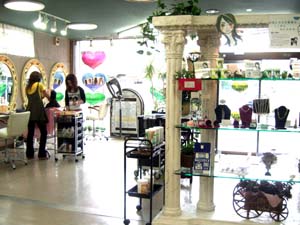 Secondly, Pay Forward-YUI- is located near the main gate, next to Hirahata post office. Parking is available at the back of the salon. The owner started in the business when she was 21 years old by working for a few salons. At the age of 26, she started working for herself from home and finally opened this salon near the base two years ago. Her career extends over 20 years, and was built up from many experiences with the Japanese and American people in Misawa city. She uses some American products for shampoo and conditioning. This salon's unique characteristic is that it offers all natural domestic organic coloring and permanent creams, and moisturized water permanent and coloring beside some regular inexpensive hair salon goods. From her extensive experiences, she has learned that she should offer these high quality and safe products to her customers. Not only are they safe in the staff’s hands, these products are also safe and soft on the hair and scalp, so your hair stays healthier. With confidence, she recommends her goods and services to pregnant ladies in particular. She strongly considers the eco function of her business as well; as it were, keeping Misawa’s water clean is her responsibility beyond her business. Her business hours are different from the other salons. She opens her salon from 10a.m. – 10p.m. on Friday besides the regular hours. If you would like to pamper yourself on Friday night for a special date or event, this is the place.
Secondly, Pay Forward-YUI- is located near the main gate, next to Hirahata post office. Parking is available at the back of the salon. The owner started in the business when she was 21 years old by working for a few salons. At the age of 26, she started working for herself from home and finally opened this salon near the base two years ago. Her career extends over 20 years, and was built up from many experiences with the Japanese and American people in Misawa city. She uses some American products for shampoo and conditioning. This salon's unique characteristic is that it offers all natural domestic organic coloring and permanent creams, and moisturized water permanent and coloring beside some regular inexpensive hair salon goods. From her extensive experiences, she has learned that she should offer these high quality and safe products to her customers. Not only are they safe in the staff’s hands, these products are also safe and soft on the hair and scalp, so your hair stays healthier. With confidence, she recommends her goods and services to pregnant ladies in particular. She strongly considers the eco function of her business as well; as it were, keeping Misawa’s water clean is her responsibility beyond her business. Her business hours are different from the other salons. She opens her salon from 10a.m. – 10p.m. on Friday besides the regular hours. If you would like to pamper yourself on Friday night for a special date or event, this is the place.
For their upcoming 3rd anniversary this November, they have a new project starting: Kimono rental and hair set up service for a reasonable price. In the future, the owner is willing to start aromatherapy massages for the total relaxation. The salon offers some lounging space, with comfortable couches and tea tables set up like a café. It is a fun place to visit with your girlfriends, where you can discuss your new look. Moreover, she offers the scalp treatment “Cream Spa” for 3,500 yen and cut & head spa set for 4,200 yen. Gift certificates are also available. Why don’t you pamper your loved ones for their birthday or other special events?
BEAUTY STUIDO
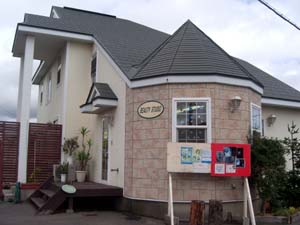 Lastly, BEAUTY STUDIO is our newest sponsor. For those who live in Oirase, this hair salon is strongly recommended. The owner, a mother of two children, works for herself at home. She opened up her salon two years ago in Oirase, right by her beautiful home. She used to practice her business in the big city of Omiya, in Saitama prefecture, for five years. She has been traveling back and forth from Aomori to Tokyo and Omiya, so she can give more depth to her skills and services. She passionately tries to learn the newest trends and techniques in the hair salon industry. When she worked for a larger hair salon, she received the Best Hair Stylist Award for the company because of her advanced haircut skills. She has developed her haircut skills even further after taking a seminar by one of the top hair stylists in Tokyo. The owner’s personality is very frank and honest. She is a great listener and also a reliable adviser.
Beside her home business, she is also a licensed home-helper, and performs her job at elder’s homes. She told me that she enjoys working from home because she can provide one-on-one service to meet her customer’s needs and comfortability, in contrast to the busy hair salons, which often pass customers off from stylist to stylist. This hair salon is located in Oirase town’s residential area, and provides a peaceful and relaxing atmosphere. The salon chairs are set by large windows, so customers can receive some nice, warm sunshine. Since the owner only takes customers by appointment, she reserves sufficient time just for you as a V.I.P. As long as you reserve your appointment in advance, she will be there for you regardless of regular business hours.
Lastly, BEAUTY STUDIO is our newest sponsor. For those who live in Oirase, this hair salon is strongly recommended. The owner, a mother of two children, works for herself at home. She opened up her salon two years ago in Oirase, right by her beautiful home. She used to practice her business in the big city of Omiya, in Saitama prefecture, for five years. She has been traveling back and forth from Aomori to Tokyo and Omiya, so she can give more depth to her skills and services. She passionately tries to learn the newest trends and techniques in the hair salon industry. When she worked for a larger hair salon, she received the Best Hair Stylist Award for the company because of her advanced haircut skills. She has developed her haircut skills even further after taking a seminar by one of the top hair stylists in Tokyo. The owner’s personality is very frank and honest. She is a great listener and also a reliable adviser.
Beside her home business, she is also a licensed home-helper, and performs her job at elder’s homes. She told me that she enjoys working from home because she can provide one-on-one service to meet her customer’s needs and comfortability, in contrast to the busy hair salons, which often pass customers off from stylist to stylist. This hair salon is located in Oirase town’s residential area, and provides a peaceful and relaxing atmosphere. The salon chairs are set by large windows, so customers can receive some nice, warm sunshine. Since the owner only takes customers by appointment, she reserves sufficient time just for you as a V.I.P. As long as you reserve your appointment in advance, she will be there for you regardless of regular business hours.
Furthermore, this hair salon offers the new and highly advanced permanent service called air wave by TAKARA BELMONT. You can check the various hairstyles in their catalogs at http://www.airwave.bz/ (Japanese only). This special machine has succeeded in making your hair much more naturally smooth and silkier than conventional hot-press permanent methods. It uses a special cream, which is very soft on your hair and scalp. Your hair smells fruity in contrast to the regular permanent stinging odors. The air wave also lasts in your hair longer than the regular permanents, since it will not damage your hair as much as before. The great thing about air wave is that it is easy to arrange your hair because the permanent hair stays the shape as you set it up as, similar to how a wrinkle-free shirt loses its wrinkles without ironing. You won’t need any special tools, such as curling irons or hair rollers. When I got my hair done there, the owner used hair cream to show me how to shape a spiral wave. The next day, I could easily arrange my hair just by hand in a different way, and my hair stayed any way I shaped. She also advised me to use treatment after washing my hair, and put on another rinse-free treatment before blow-drying my hair. By keeping moisture in your hair, your permanent hair lasts silky and longer than ever. She is also good at dyeing or highlighting hair because she knows what she is doing. I liked that she uses all natural organic coloring cream. Out of all the many hair salons in Misawa and Oirase, BEAUTY STUDIO accepts Visa/MasterCard. This is handy for people who are not used to carrying cash.
Please check the sponsor’s ads on this page for their contact information. Each hair salon offers wonderful services. I hope you will find your favorite place during your stay in Japan.
No. 121 (8/8/08)
Bugs! OFF!
By Nao H. Kauffman
The Insider staff writer
Those of you who just learned about Japan’s humidity and muggy weather might be also having a hard time with mosquitoes' bites. It may be useful to know how to avoid them and what to use for it in Japan.
Why do they bite you?
Mosquitoes are attracted by the scent of your sweaty skin and the carbon dioxide that you breathe out. They suck your blood and try to steal your proteins in order to prosper.What to do
Try to wipe your body more often. When the outside temperature drops, try to wear long-sleeve shirts and pants. Use *the spray* and items which keeps mosquitoes away from you.How to make an original spray
- 3ml clean water- 16ml isopropyl Alcohol
- 20drops of Aromatic oil, especially Lemon Eucalyptus
Just mix the above three items into a spray bottle and shake well! Use it within two weeks.
Mosquitoes dislike the scent of the aromatic oil. This mix is also soft on your skin especially for infants. Keep away out of your eye when you spray.
There are a variety of products in the local stores, especially Homac (home center).
“Avoid the items which include DEET."
Please check the link at http://en.wikipedia.org/wiki/DEET.
For indoors/outdoors,
This item is called Katori Senkou (the traditional pig base and the box of spiral incenses.) Basically, the smoke from this lighted spiral incense helps keeping mosquitoes away from you. For infants and small children, The wrist band which holds the aromatic oil could be a safe item like the home-made spray.For kids and adults,
 There are many battery-operated items. There is a small cartridge which last 30-40hours or more depending usage. You can wear it like a necklace or watch. It could be clipped onto your belt like a superhero.
There are many battery-operated items. There is a small cartridge which last 30-40hours or more depending usage. You can wear it like a necklace or watch. It could be clipped onto your belt like a superhero.
Treatment
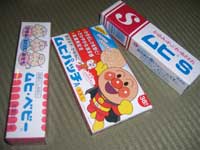 Once mosquitoes/bugs bite you, you can use the following items in the picture to sooth your skin. It is called “MUHI”, an over-the-counter medicated cream. The adult version contains menthol. You should not use around the eye. For small children, “The Muhi Baby” is a wonderful item because you do not have to worry about your children touching the cream with their hands and stinging their nose or eyes by accident. You can also try the famous character ANPANMAN patch, used just like a band aid on itching or swollen spots.
Once mosquitoes/bugs bite you, you can use the following items in the picture to sooth your skin. It is called “MUHI”, an over-the-counter medicated cream. The adult version contains menthol. You should not use around the eye. For small children, “The Muhi Baby” is a wonderful item because you do not have to worry about your children touching the cream with their hands and stinging their nose or eyes by accident. You can also try the famous character ANPANMAN patch, used just like a band aid on itching or swollen spots.You can usually get these items for protection at the home center or local supermarkets. However, for this type of treatment, you will be able to find the items at some drugstores like Super Asahi Drug, Happy Drug etc. “MUHI wa Doko Desuka (Where is muhi?)” Ask the store clerk.
No.120 (7/25/08)
Amber. Doughnuts
By Nao H. Kauffman
The Insider staff writer
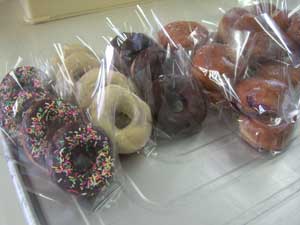 Amber. Doughnuts produced by OFFICE 21 has started their business in Misawa since Nov. 2007. The owner named this factory after the color of amber, which the dough changes its color into a beautiful brown, while cooking. The home-made American style doughnuts are available in various kinds such as plain glazed ones for 100 yen or lemon white chocolate, strawberry, blueberry, apple, orange marmalade, chocolate, whipped cream, and also sprinkled topping ones for 120 yen. Packaged items are also available at the two branches of JOY M bookstores in Misawa. This local specialty has become an original in Misawa immediately. However, the doughnut maker has 40 years of experience at the Misawa Air Base bakery shop and has created his own secret recipes, not too heavy or not too sweet compared to other regular American doughnuts. It is completely different from the bakery items in local Japanese supermarkets.
Amber. Doughnuts produced by OFFICE 21 has started their business in Misawa since Nov. 2007. The owner named this factory after the color of amber, which the dough changes its color into a beautiful brown, while cooking. The home-made American style doughnuts are available in various kinds such as plain glazed ones for 100 yen or lemon white chocolate, strawberry, blueberry, apple, orange marmalade, chocolate, whipped cream, and also sprinkled topping ones for 120 yen. Packaged items are also available at the two branches of JOY M bookstores in Misawa. This local specialty has become an original in Misawa immediately. However, the doughnut maker has 40 years of experience at the Misawa Air Base bakery shop and has created his own secret recipes, not too heavy or not too sweet compared to other regular American doughnuts. It is completely different from the bakery items in local Japanese supermarkets.
 This characteristic has brought a key point for the doughnuts' popularity from Hirosaki or Aomori City to Hachinohe. Word of mouth helped spread the factory’s name; what is more, many Japanese people order a dozen doughnuts to take and share this decadence with their families who live outside Aomori. The location is near the POL gate. You can drive south from POL gate and see this factory on your left, right before the gas station JOMO. They are usually open at 9am, seven days a week, while the doughnuts last. They may close the factory without notification for their family business. The owner suggested just knocking on the door or calling if you would like to reserve many doughnuts. Although they are not prepared with English services, they more than welcome your visit to the factory. When I was there for this interview one morning, the doughnut fans kept purchasing these items. Sooner or later, most of doughnuts seemed to be gone within an hour. Why not trying such a yummy food? Great doughnuts with a Starbucks coffee from the Base Club Coffee shop would be the best match for your breakfast or snack!
This characteristic has brought a key point for the doughnuts' popularity from Hirosaki or Aomori City to Hachinohe. Word of mouth helped spread the factory’s name; what is more, many Japanese people order a dozen doughnuts to take and share this decadence with their families who live outside Aomori. The location is near the POL gate. You can drive south from POL gate and see this factory on your left, right before the gas station JOMO. They are usually open at 9am, seven days a week, while the doughnuts last. They may close the factory without notification for their family business. The owner suggested just knocking on the door or calling if you would like to reserve many doughnuts. Although they are not prepared with English services, they more than welcome your visit to the factory. When I was there for this interview one morning, the doughnut fans kept purchasing these items. Sooner or later, most of doughnuts seemed to be gone within an hour. Why not trying such a yummy food? Great doughnuts with a Starbucks coffee from the Base Club Coffee shop would be the best match for your breakfast or snack!
No.119 (7/11/08)
Summer! Sparkling! Beer!
By Nao H. Kauffman
The Insider staff writer
 Once hot and muggy weather hits Misawa, many people would not be able to resist having a cold and sparkling beer, especially after a long day of work, sports, or Onsen. If you prefer beer to other hard liquors, it’s always interesting to taste something new and local rather than the general brands made in the U.S.A. When you visit local restaurants in Misawa, you may often see three major local brands being served: Sapporo, Asahi, or Kirin, but you may see some other brands in stores such as Super Asahi Drug.
Once hot and muggy weather hits Misawa, many people would not be able to resist having a cold and sparkling beer, especially after a long day of work, sports, or Onsen. If you prefer beer to other hard liquors, it’s always interesting to taste something new and local rather than the general brands made in the U.S.A. When you visit local restaurants in Misawa, you may often see three major local brands being served: Sapporo, Asahi, or Kirin, but you may see some other brands in stores such as Super Asahi Drug.
My husband is one of those who are curious about challenging new kinds although he passionately loves his hometown beer called Yuenglings or YEBISU by Sapporo. Once he told me how beer prices have gone up compared to the first time he was stationed in Misawa, just as gas prices have risen. He used to drink regularly “Sapporo Nama” or now upgraded to “YEBISU”, the finest beer among all of the Sapporo brands. Lately, though, he hardly purchases Japanese beer. He once asked me, “Why are some Japanese beers super expensive like $40-$50 a case and others are almost half price?” By looking at two different beers in my fridge and tasting both of them, I could not have a picture what he was asking at that time until I actually visited the store to check the merchandise. Now I am having a hard time to look for a big sale on beer or find the differences in those many reasonable priced beers. Here I would like to define two kinds of beer; as it were: the true beer and fake beer. In the definition of beer (生) there are two types of beers according to the alcohol tax in Japan, one is malt 100%(麦芽100%) with alcohol more than 1%, the other is the combination of malt, hop, water or rice, and the total original ingredients' weight has to be smaller than 50% of malt weight. Moreover, the usage of malt has to be 66.7%. After all, the rest of all are categorized Happoshu (発泡酒) –“sparkling spirits” or “low-malt beer.” In other words, these beer-like beverages with less than 67% malt content are not real beer. Japan alcohol tax system divides these into three categories based on malt content: 50 to 67%, 25-50%, and less than 25%. As the alcohol tax varies, the prices are differentiated from one kind to another.
With alcohol tax revenues decreasing as a result of happoshu’ popularity, the Japanese government finally raised the nation’s tax on low malt beers. In 1996, the tax for products containing 50 to 67% malt was raised to that of beer. Brewers followed suit by lowering the malt content of their products. Today, most happoshu contains less than 25% malt, putting it in the lowest tax category of low-malt beer. Japanese brewers recently have released dozens of brands in attempt to increase their market share. Most of these are marketed as healthier products with reduced carbohydrates. A new trend has come by using un-malted barley such as Sapporo's Mugi 100% Nama-shibori. Beer-flavored beverages, collectively dubbed “the third beer” by the mass media, have been developed to compete with happoshu. These alcoholic products fall under categories not yet as highly taxed. The third beer beverages either use malt alternatives, or they are a mix of happoshu and another type of alcohol. When comparing 350 ml cans, the third beer brands can be 10 to 25 yen cheaper than happoshu.
If you are used to the finest beer from beer Mecca, Germany, you would be able to taste the differences among most of complicated beers in Japan because you prefer the smell of malt and deep flavor of hop. That is the real beer. However, it is completely up to your preferences as you do not mind these new trends and be mo re economical. My advice here is when you check the prices and labels, check the words“麦芽 100%,” “発泡酒,” or “第三のビール” on the label as the price is descendent.
No. 118 (6/27/08)
Cherries in Nambu/ Nagawa
By Nao Hanada Kauffman
The Insider staff writer
Where & When
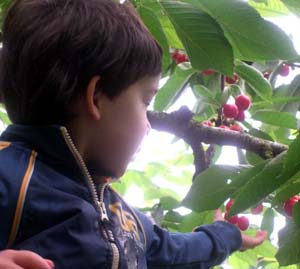 Jun 21st (Sat) through July 21st (Mon)
Jun 21st (Sat) through July 21st (Mon)Time: 9:00AM – 5:00PM
Place: 59 orchards in town
Price: Person over 13years old -- 1000 yen
Elementary School Student – 700 yen
Children over 3 years old – 300 yen
All you can pick and eat for 60 minutes
** Just pay by weight for cherries to take home or send as a gift.**
When early summer has arrived, it is time to go outdoors. Why don't you go on a picnic? I highly recommend a tour of cherry picking in Nambu / Nagawa town near Hachinohe. You may see big American cherries around on the supermarkets’'shelves. There, you will be seeing a lot of Japanese cherries called “Sato Nishiki(佐藤錦)”. “Sato Nishiki” is originally produced in Yamagata prefecture, and the largest production is there in Japan. Aomori prefecture followed behind Yamagata in production of “Sato Nishiki” thanks to the similar climate and suitable lands.
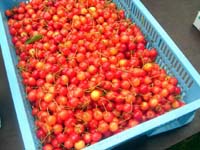 There are several events on weekends such as a ceremony, ground golf tournament, and cherry seed spitting competition etc. Compared to the sweet American cherries, domestic cherries are a little tart, but its sweetness is particularly delicate. In order to pick the best ones, try to find bright colors ones as it is often said “Red Gem”. Avoid dark blackish ones or the ones with spots on their skin. The greener stems are fresher than brownish ones. Do not worry about rainy days. All the orchards are sheltered by vinyl tents.
You can enjoy your trip whether rain or shine.
There are several events on weekends such as a ceremony, ground golf tournament, and cherry seed spitting competition etc. Compared to the sweet American cherries, domestic cherries are a little tart, but its sweetness is particularly delicate. In order to pick the best ones, try to find bright colors ones as it is often said “Red Gem”. Avoid dark blackish ones or the ones with spots on their skin. The greener stems are fresher than brownish ones. Do not worry about rainy days. All the orchards are sheltered by vinyl tents.
You can enjoy your trip whether rain or shine.
Directions:
Go to Hachinohe and take Rt. 104, and it will be 20km drive from downtown Hachinohe. Also, you could take Rt. 4 from Towada to south and find Rt. 134 for signs of cherries in Nagawa or Nambu. Cherries are written さくらんぼ in Japanese.No. 116 (4/25/08)
Welfare and Educational Funds in Japan
By Nao Hanada Kauffman
The Insider staff writer
If you are living in the US or related to educational fields, you might have seen the logo Box Tops for Education and might have been contributing to this donation. In Japan, there are two well-known funds called the Bell Mark and Pull-Top Campaigns. In Misawa, you may find the collection boxes which some schools have set up at local supermarkets such as UNIVERSE. The Bell Mark Campaign started in 1960 for the 80th anniversary of Asahi Newspaper for the purpose of supporting educational facilities. A variety of major products have this logo mark. This "bell" mark symbolizes: "Ring the bell with love in Japan and worldwide." Each "bell" mark has points. One point counts as 1 yen. By collecting these points and mailing them to the organization, the organization purchases educational supplies and utilizes the collected money for educational buildings or welfare facilities. Some rebates are donated back to the organization. After the 1980s, welfare organizations were allowed to purchase wheel chairs with the funds. Furthermore, the funds can be directly donated to UNESCO and UNICEF, JAPAN in order to build new schools or supply books and materials for children in third world countries. PTA and students mostly contribute to another campaign known as "Pull-Top." Most currently pull-tops on cans are attached. Nowadays, you detach these aluminum pull-tops and collect them to exchange money. You can donate money to purchase wheel chairs for welfare groups. However, there was a contradictory story regarding the pull-top which created a myth. We used to pull off the top from the can. People used to toss it carelessly. This became an environmental issue because animals started swallowing them. As a result, the pull-top was improved to stay on the cans. As the Bell Mark Educational Fund was expanded back in the day, people believed the pull-top could be the same as the Bell Mark Campaign. Many people collected the tops and started mailing them to the organization. One radio DJ actually encouraged the audience to cooperate and promoted this myth to a real story. Nowadays, people put this into action as a donation campaign rather than an environmental campaign. Nevertheless, you may want to remember this act should go on as recycling. Those aluminum cans themselves may have more value than the pull-tops.
Insider Art & Design Co. Ltd.
![]()
Copyright © 2014 All rights reserved.